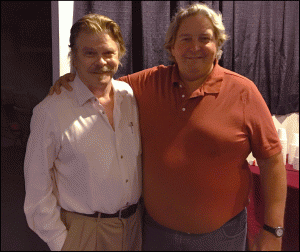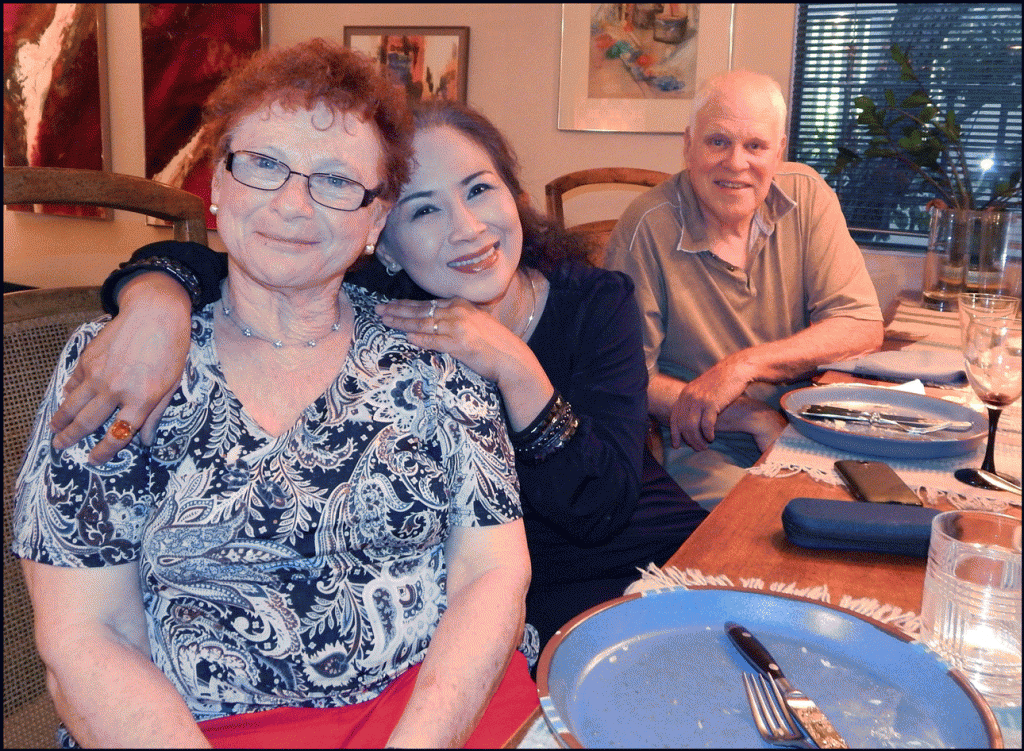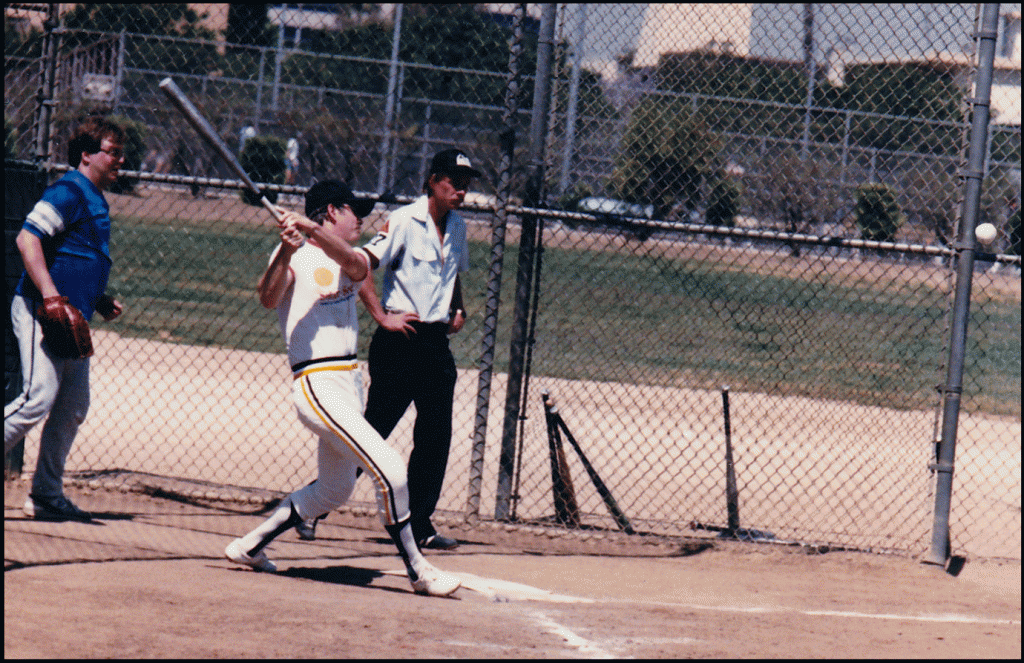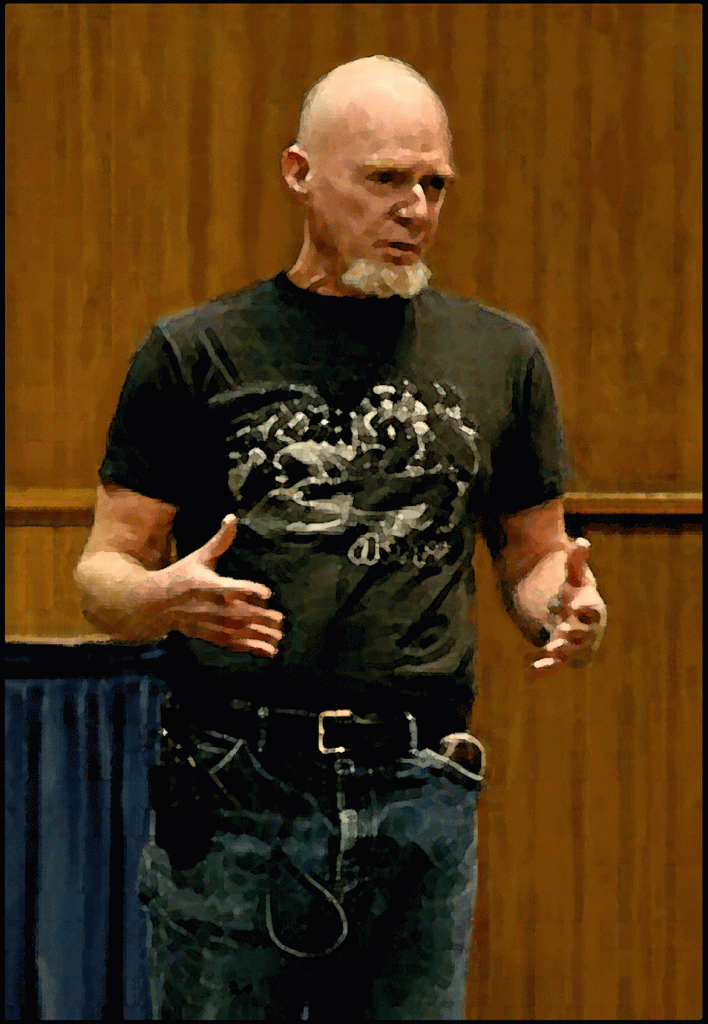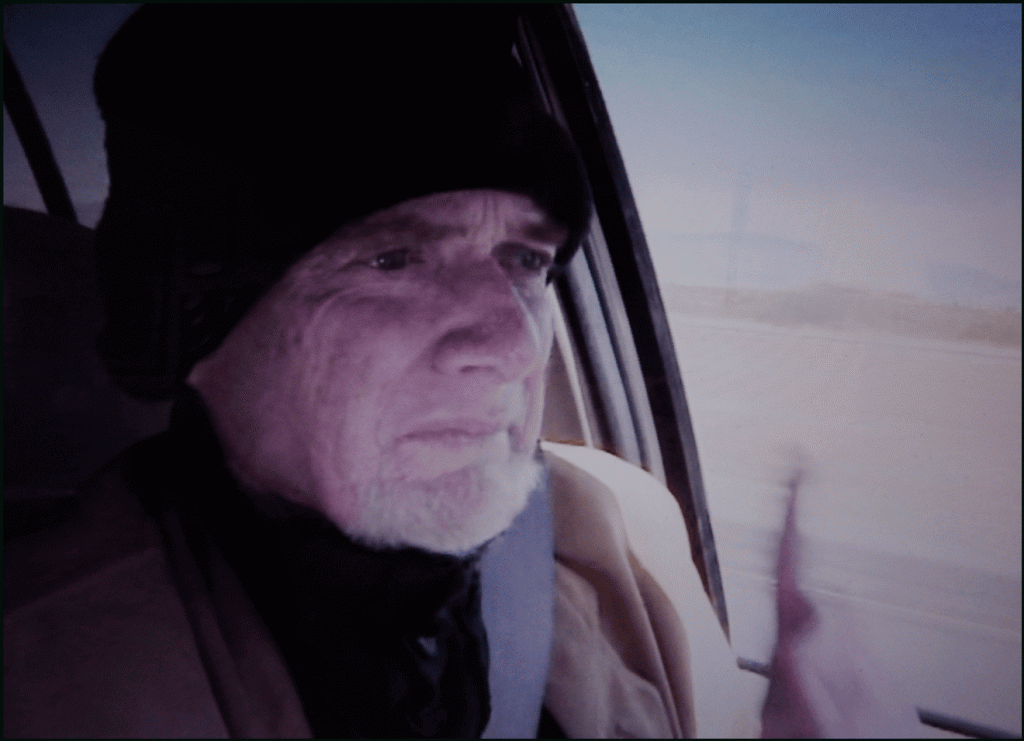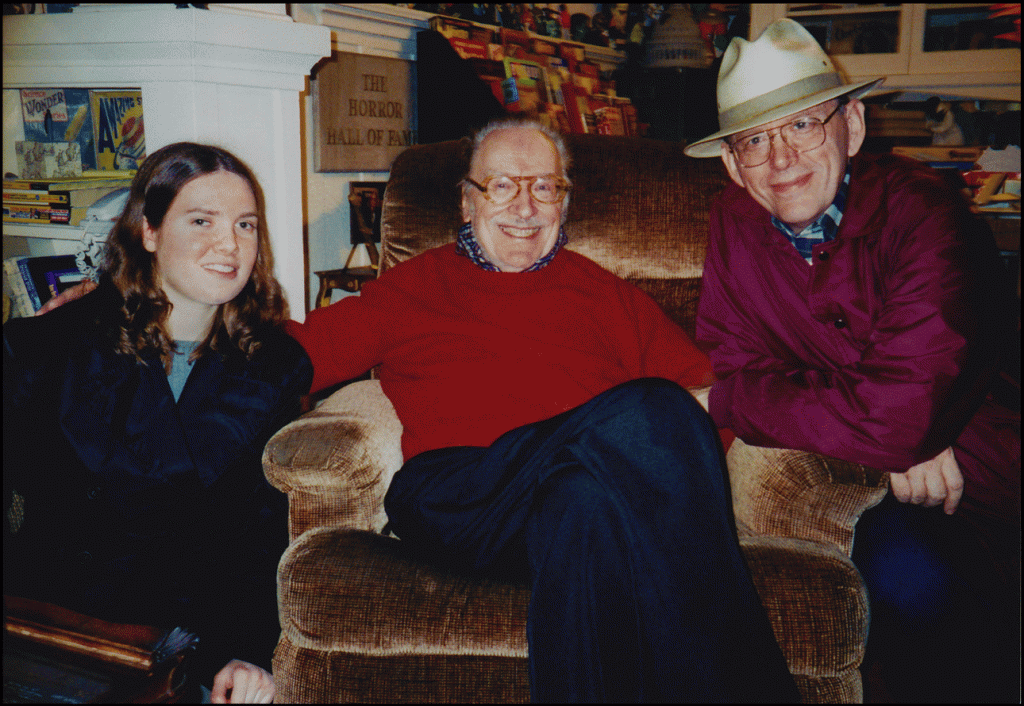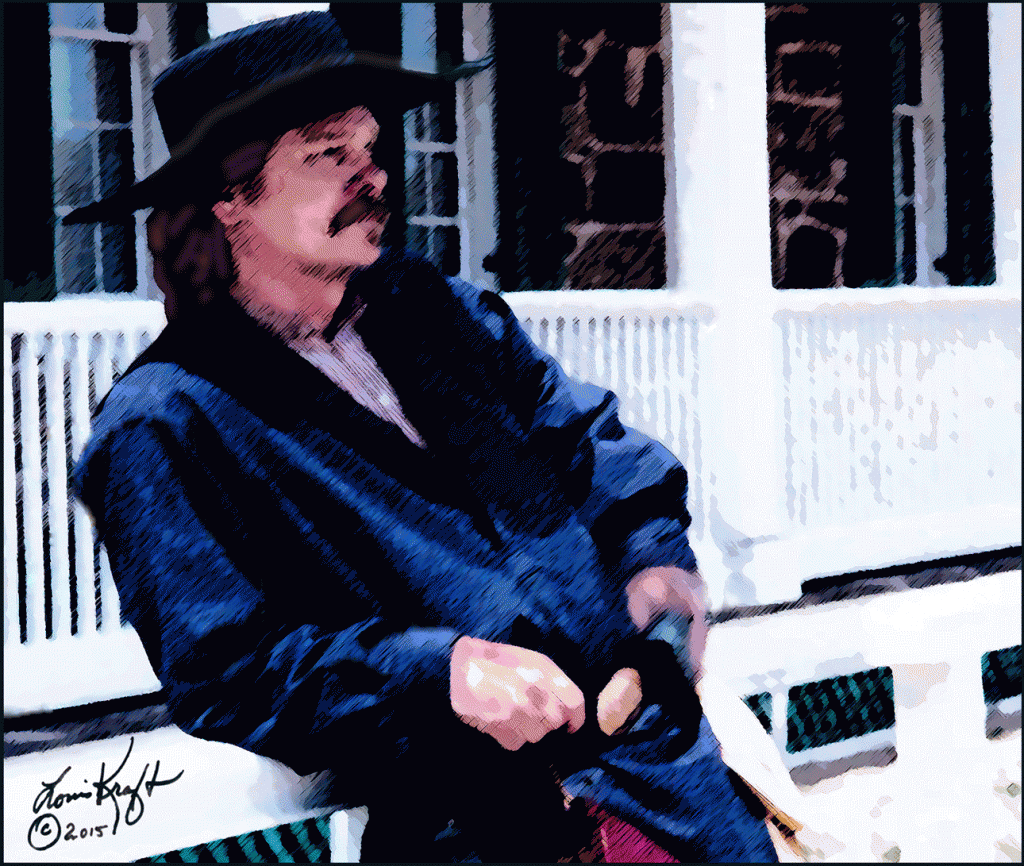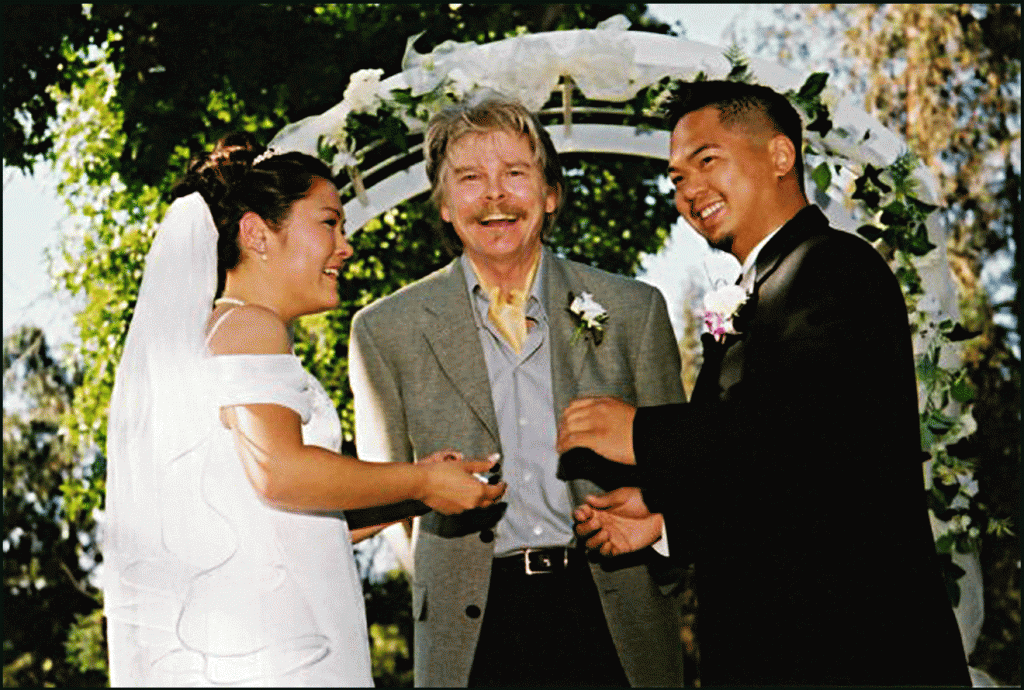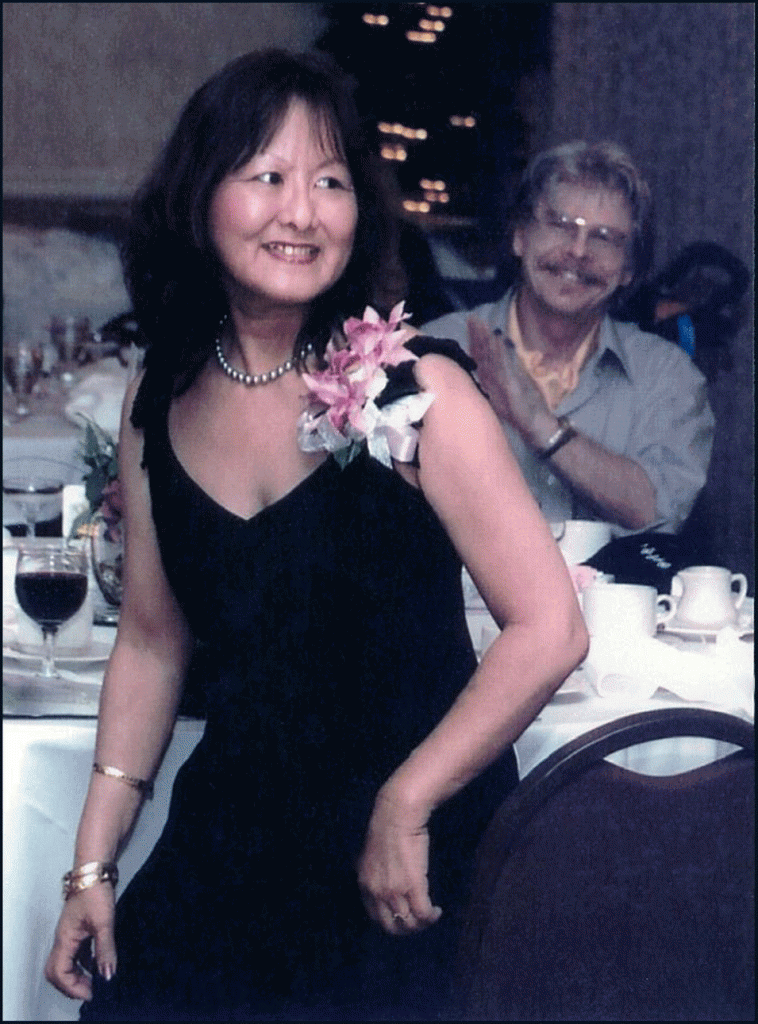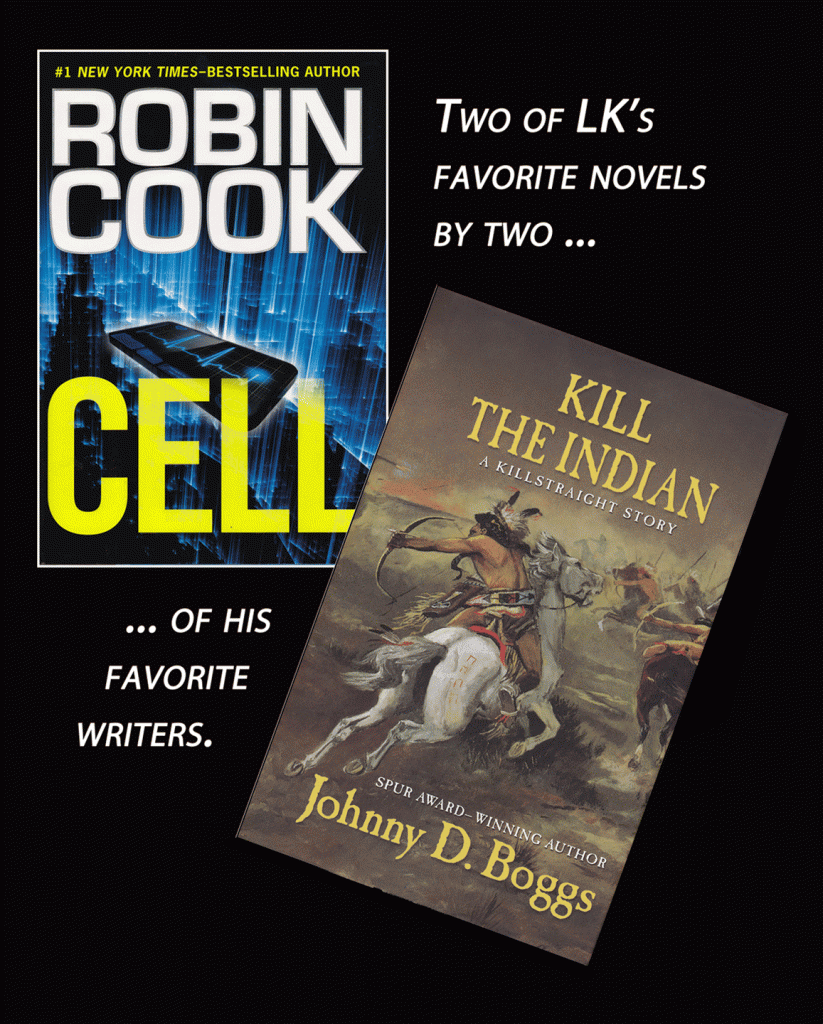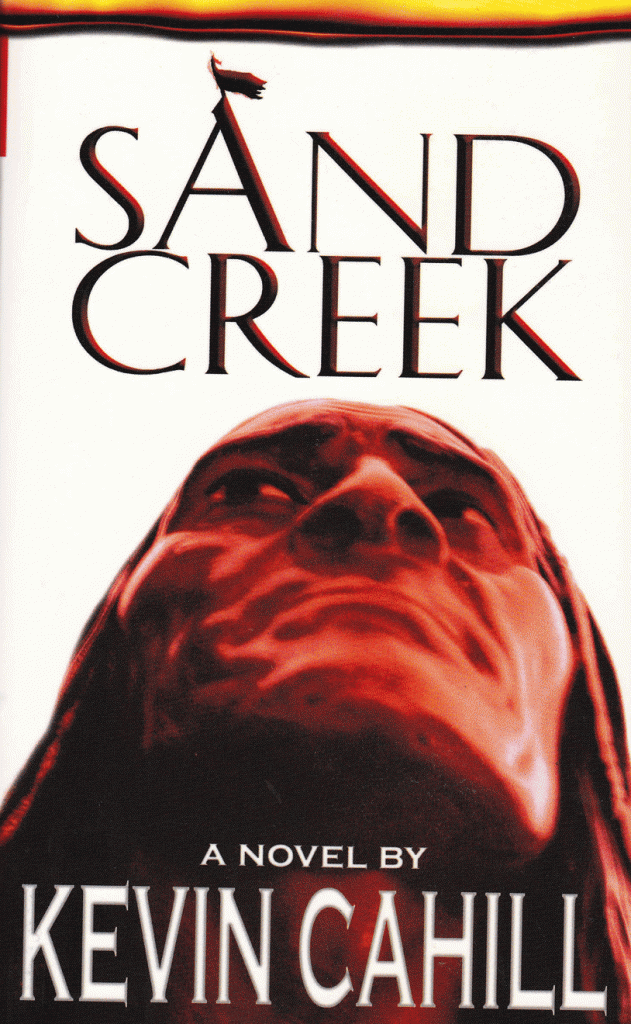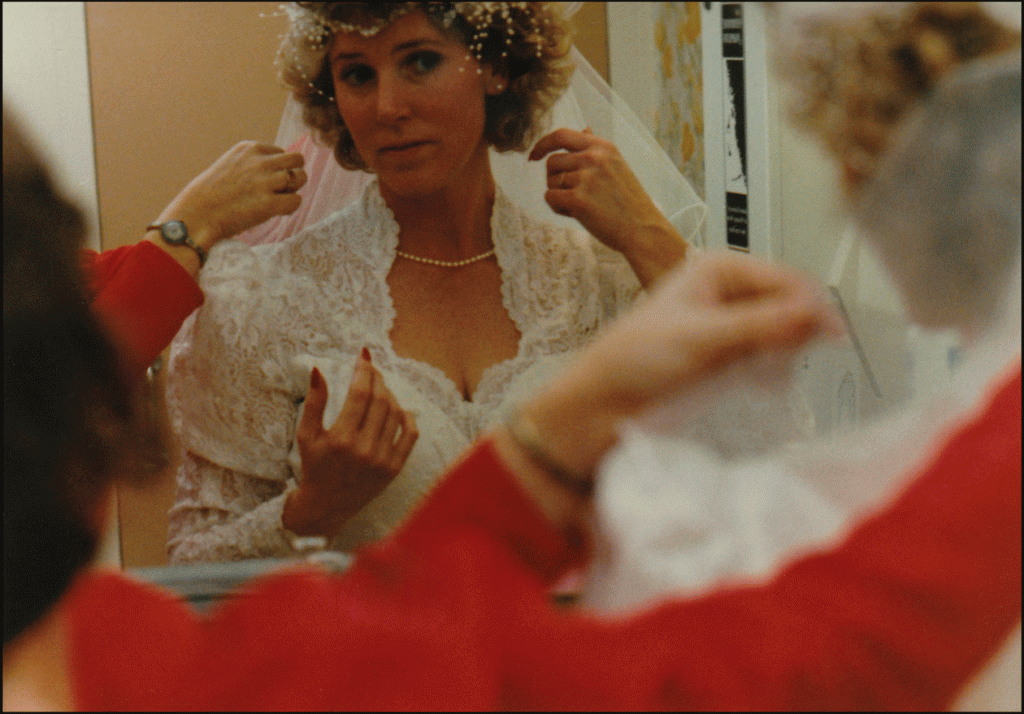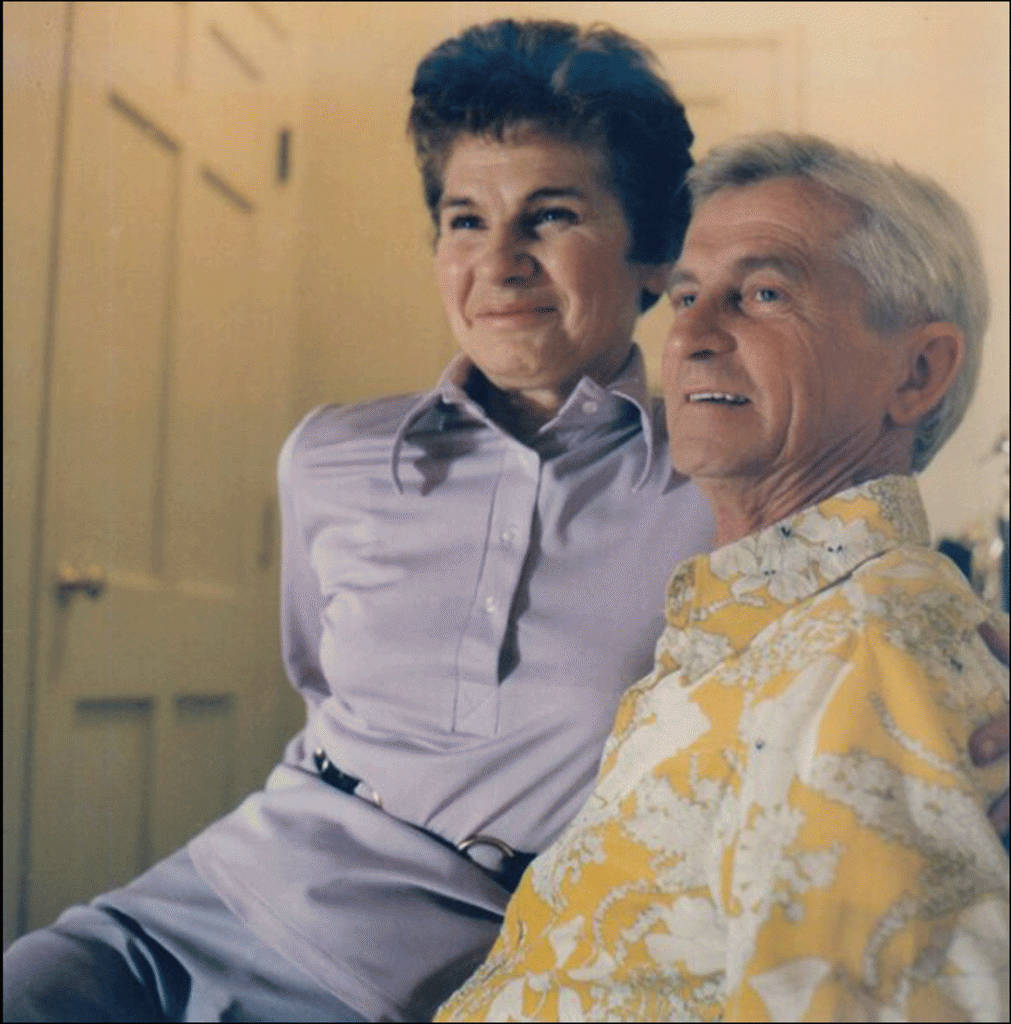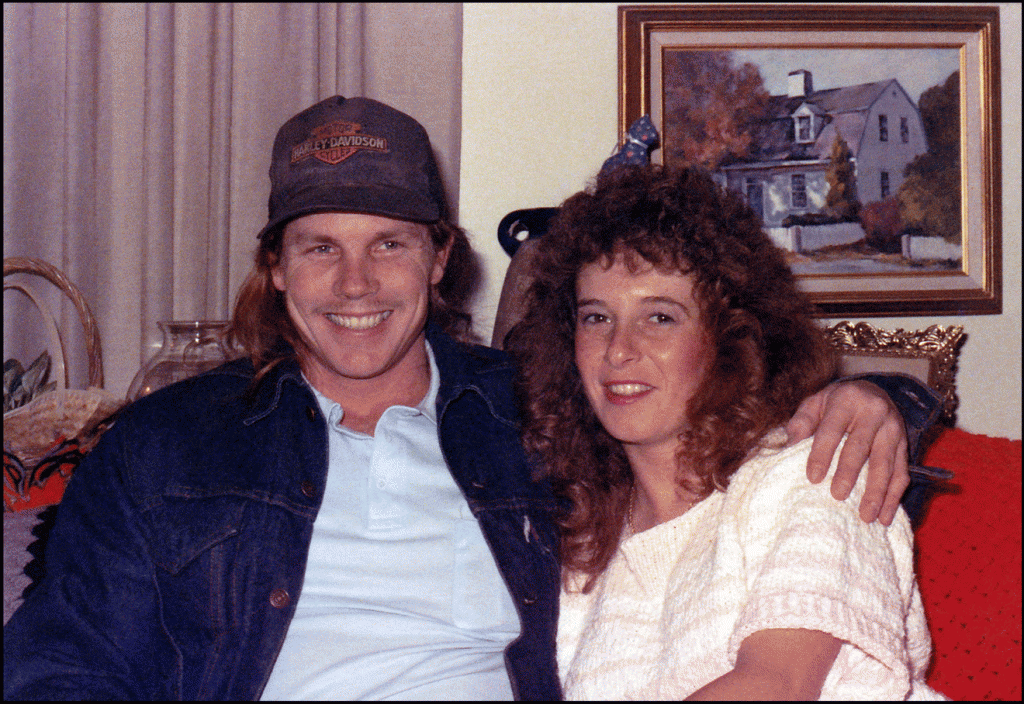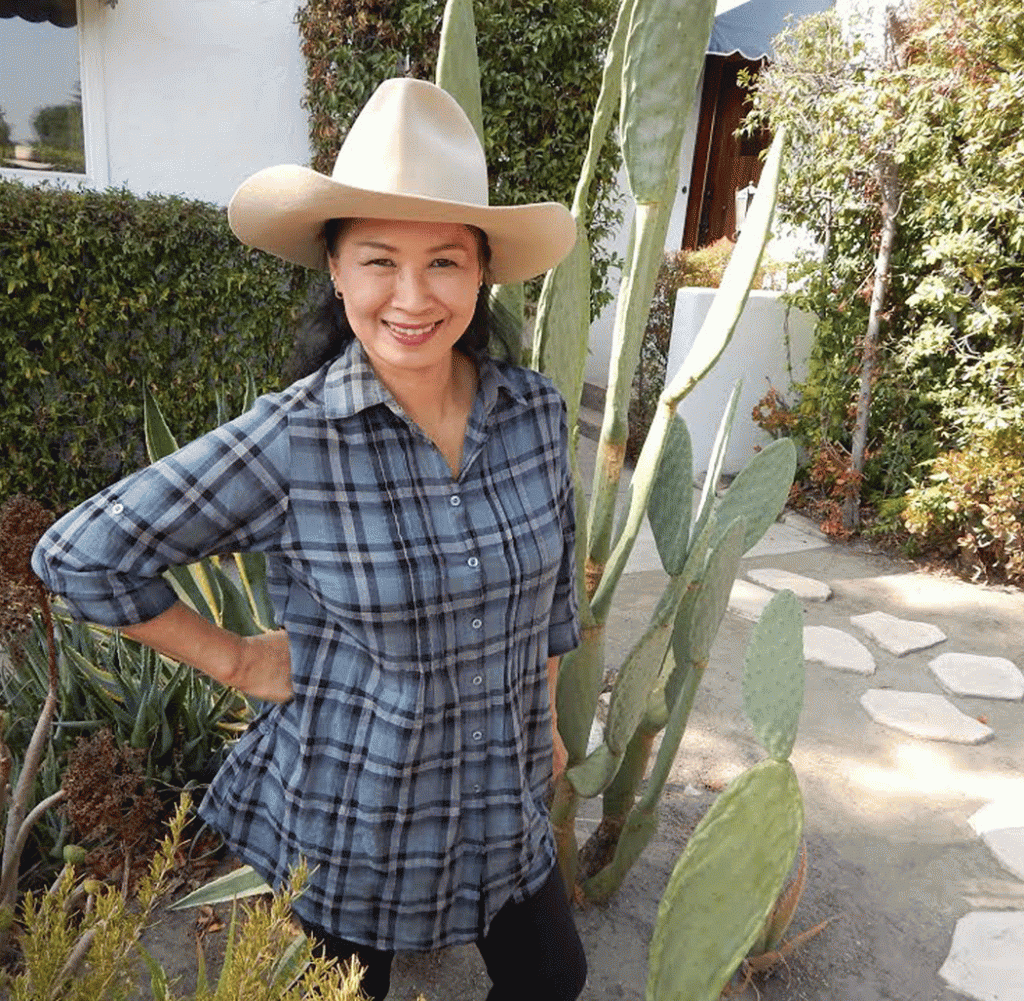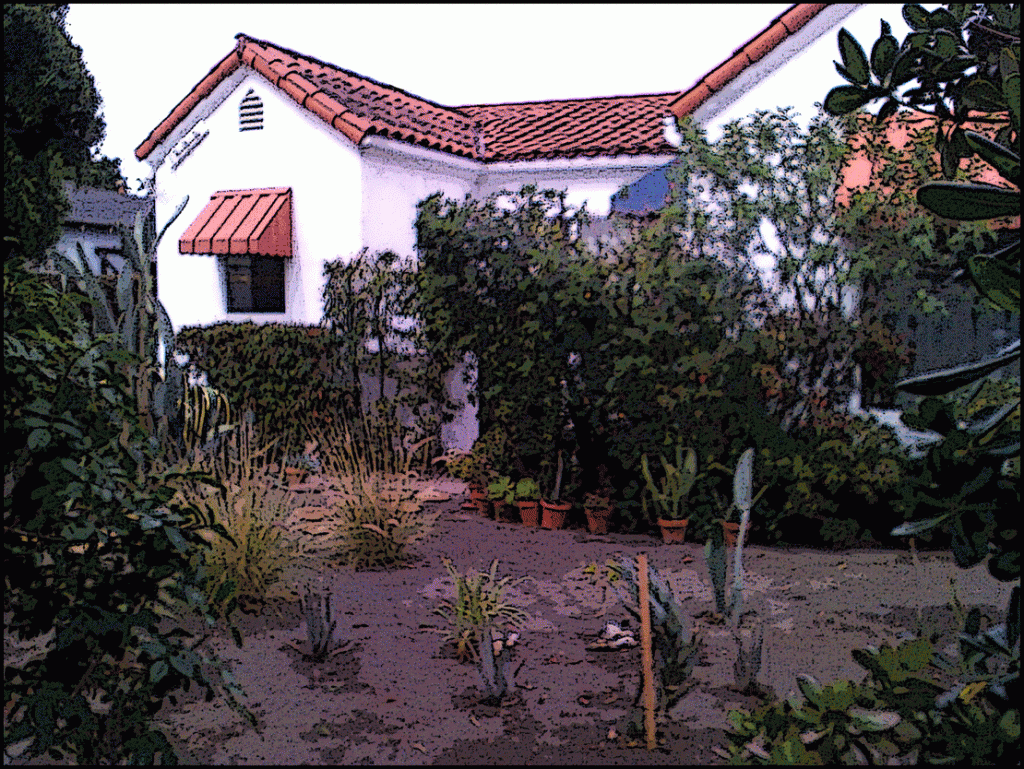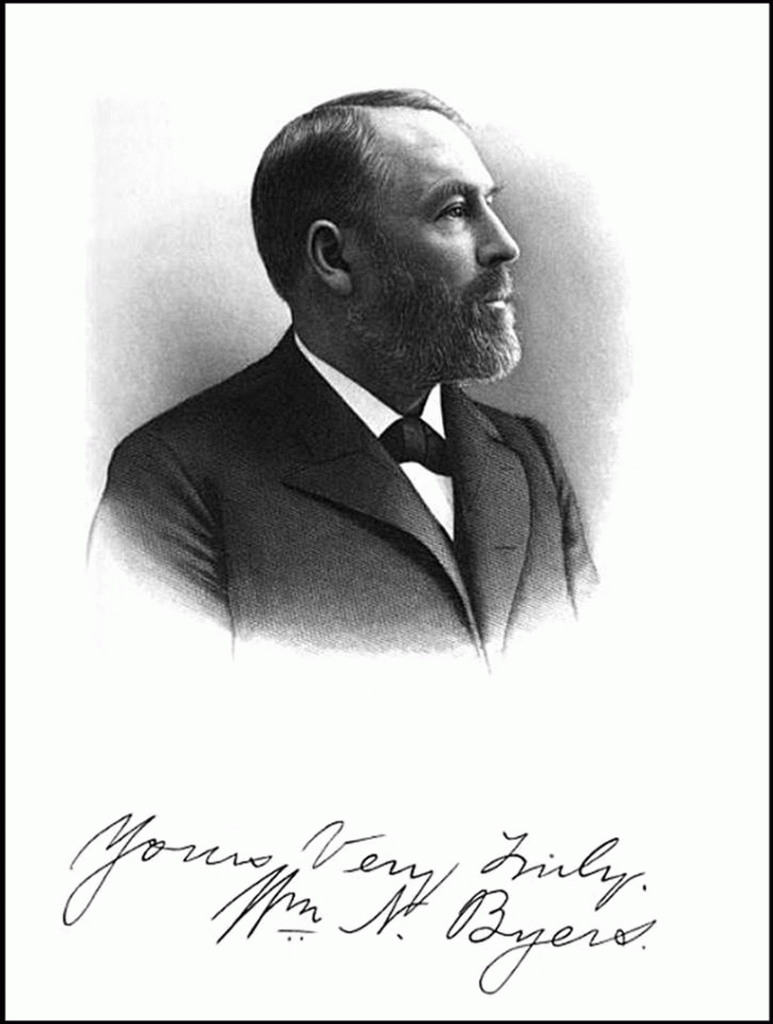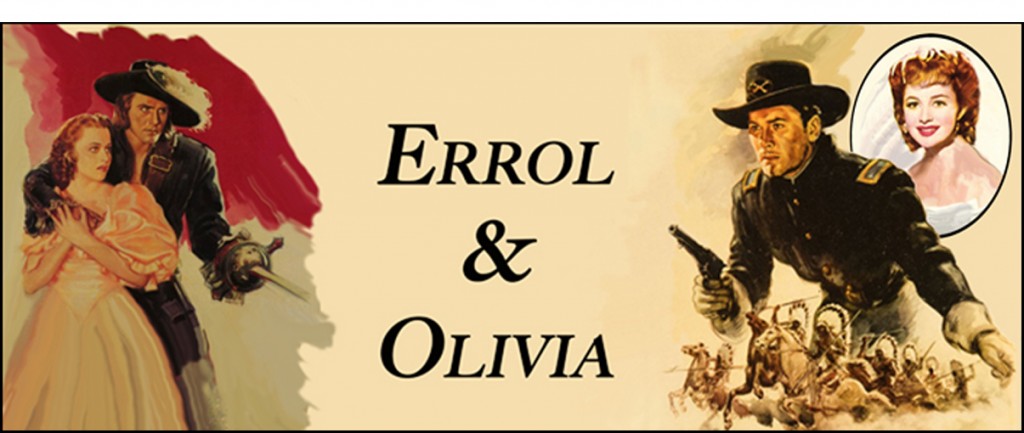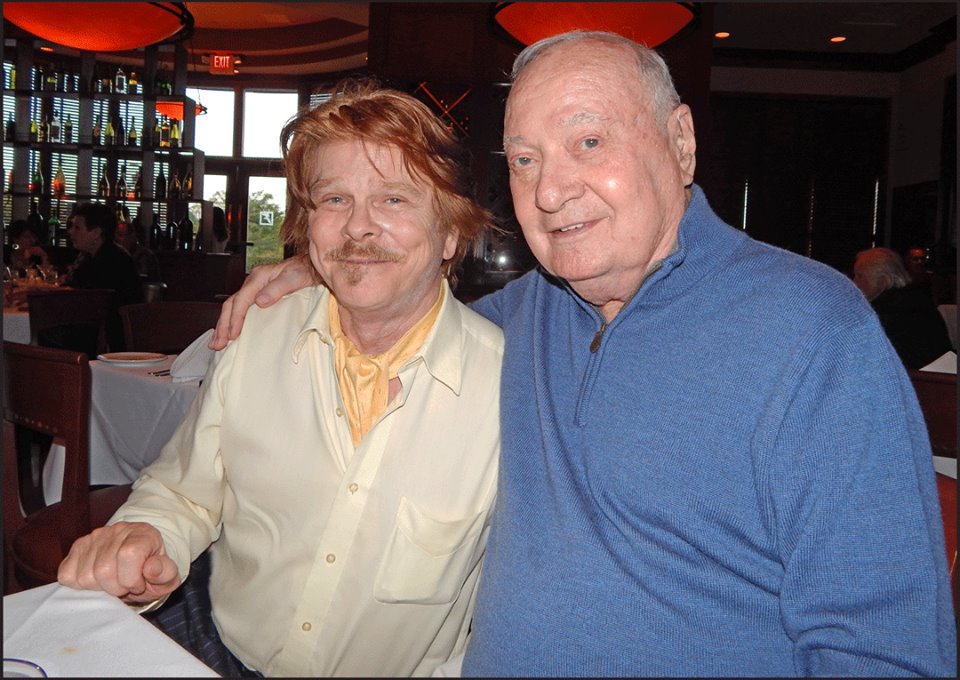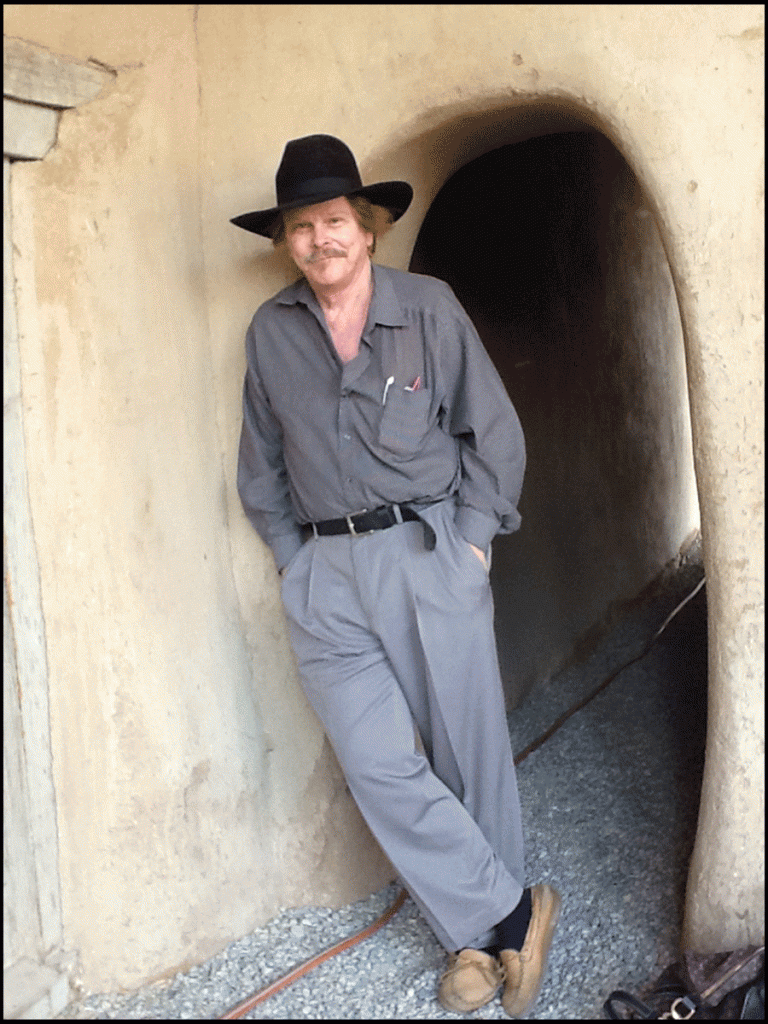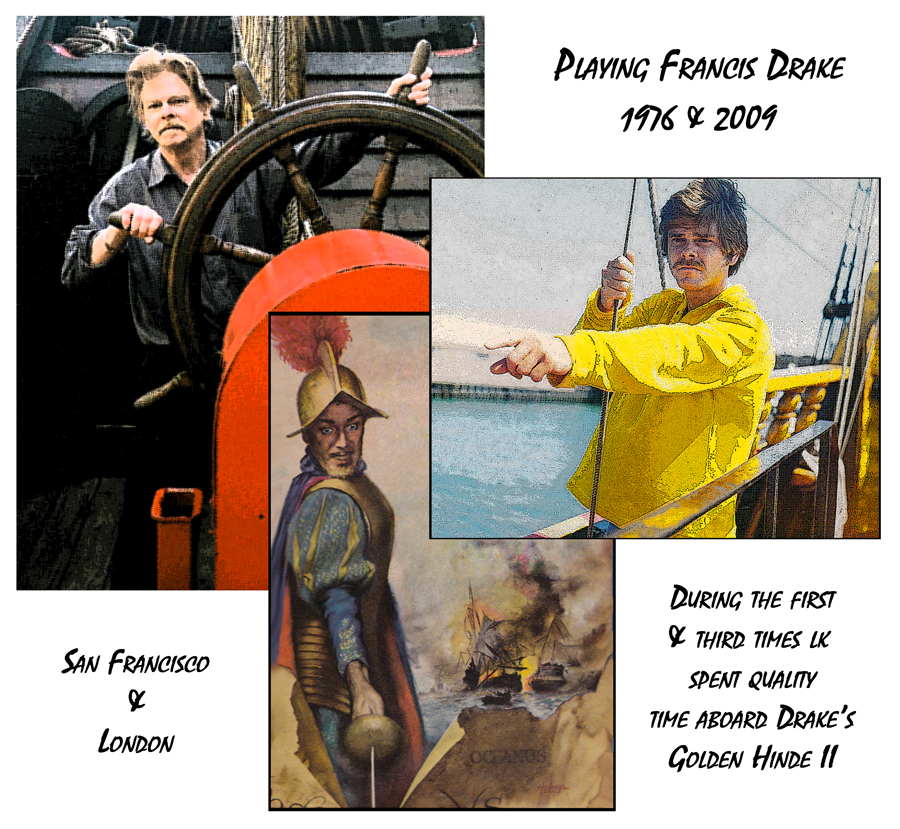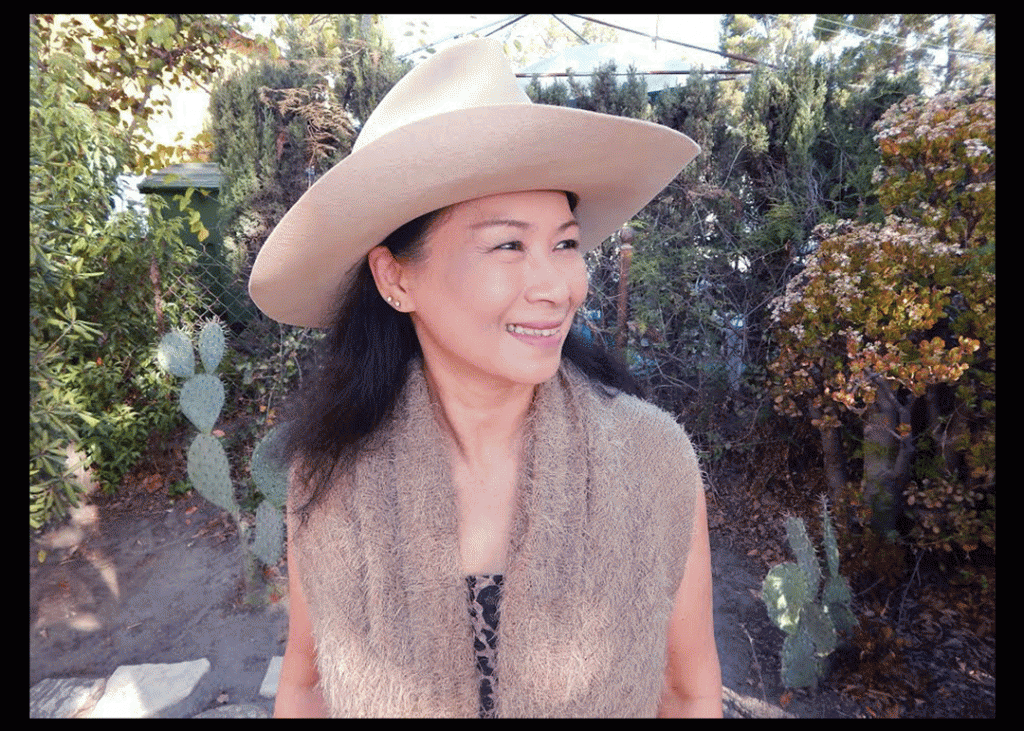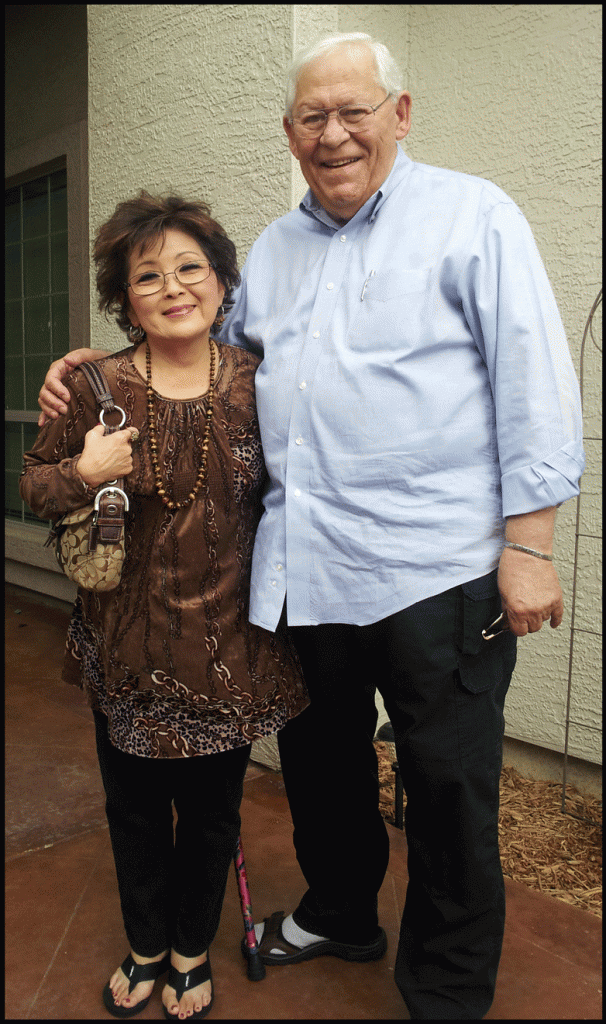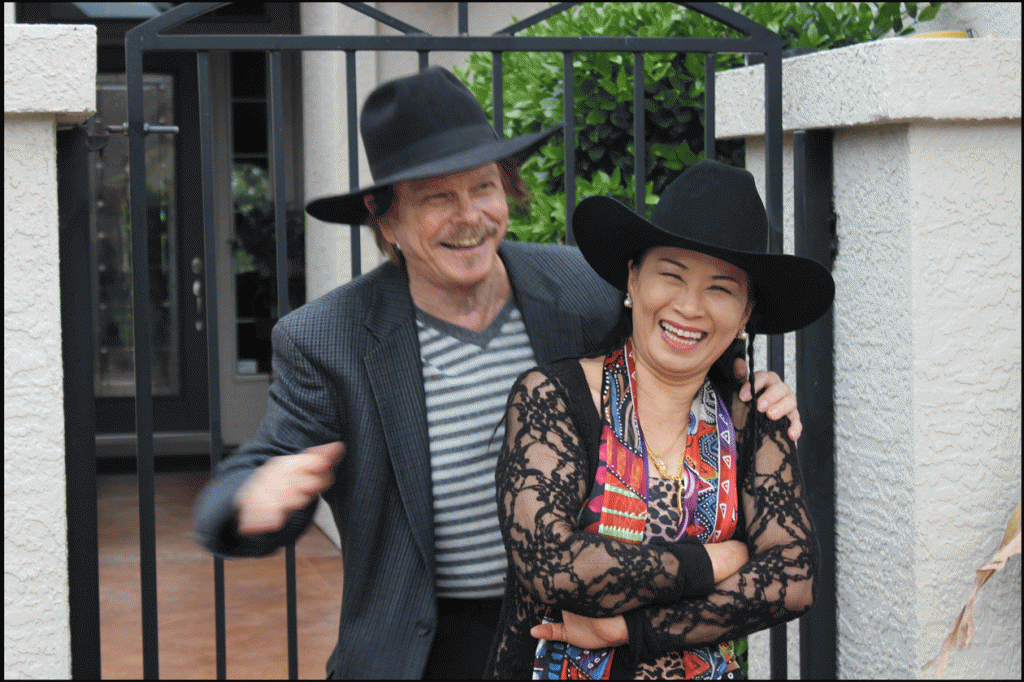Website & blogs © Louis Kraft 2013-2020
Contact Kraft at writerkraft@gmail.com or comment at the end of the blogs
I want to say upfront that my friend Tom Eubanks is the most talented person that I’ve ever known. Moreover, he has unlimited focus and energy to bring all his projects to fruition. He’s a terrific friend and to date my only director since I quit working in theater/film/TV/commercials etc. in the mid-1980s.
This blog deals with our initial literary connection, theatrical relationship,
and to where it hopefully leads us next.
Enter Tom Eubanks stage right
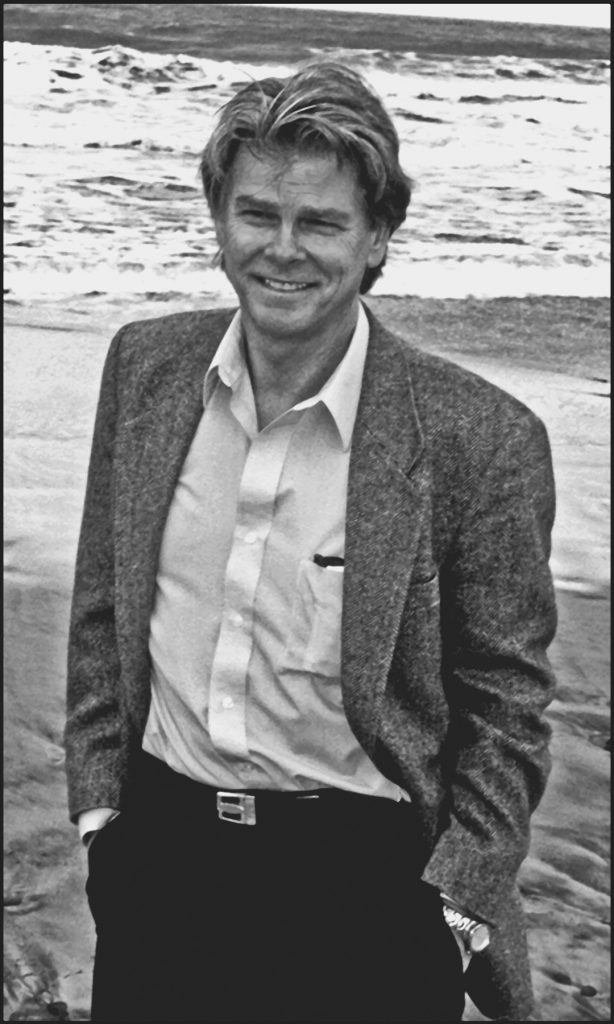
Although this image of LK dates to later than 1990, it pretty much represents my clean-cut look at that time when I wasn’t wearing boots and wide-brimmed hats. George Carmichael took this image on a beach in northern San Diego County. (photo © Louis Kraft 2001)
In spring 1990 my then wife and I bought a terrific house in Thousand Oaks, California (in Ventura County, the county north of Los Angeles).
At that time I had been selling magazine articles and giving talks mostly about race relations and the Cheyenne Indian wars of the 1860s but also baseball (current and history). I also wrote for a telecommunications software company.
Even though I freelanced nonfiction I studied fiction at UCLA at night taught by a visiting professional. … I met George Carmichael at UCLA. He was a retired aerospace engineer who sold magazine articles and had an unending curiosity in the world. We remained close friends until his death on 2apr2014. After the class ended George and I continued to study with the UCLA writer at her Westwood office/home. As at UCLA, she oversaw the discussions and critiqued the work.
Actually, some of the wanna-be novelists at this time seemed to be from other planets (but not George). One of the Westwood writers was drafting a story about Jesus Christ, who was the quarterback of a high school football team. He was serious. … How do you keep a straight face while frantically trying to figure out how to say something constructive? Not easy to do.
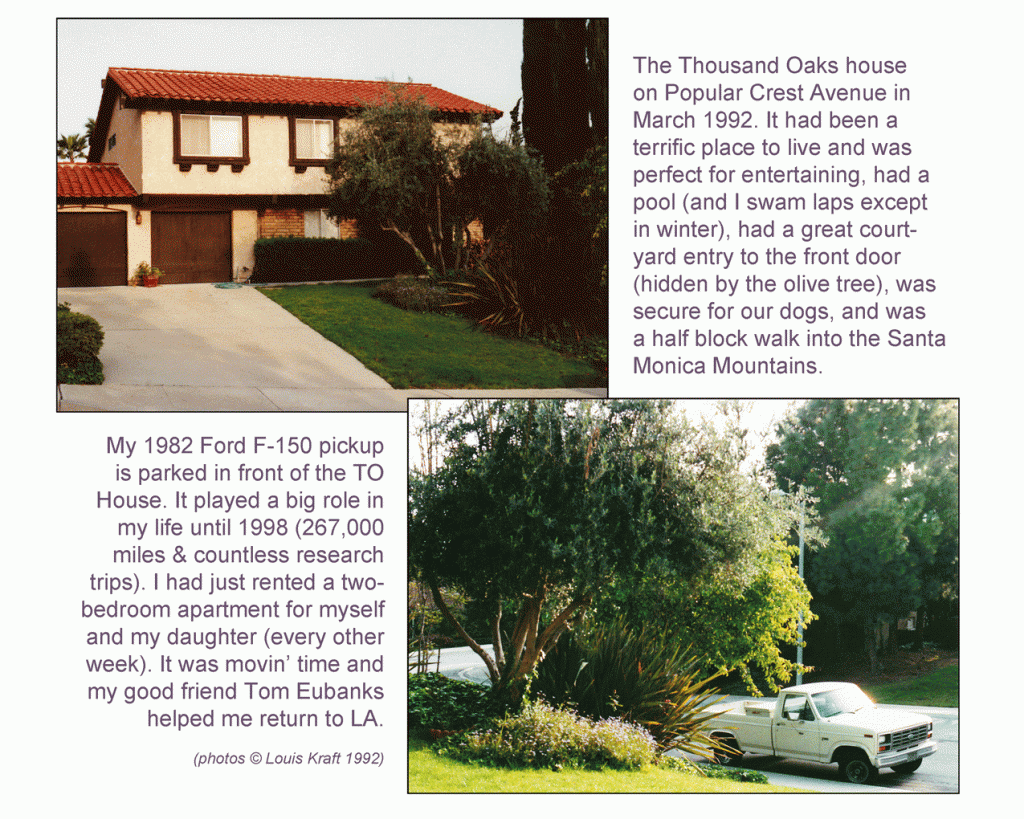
The Thousand Oaks house played a role in the publicity for The Final Showdown (see below).
After the move to Thousand Oaks a novelist that I no longer associated with suggested that I become a member of the Ventura County Writers Club and join one of the fiction groups of five, six, or seven that met weekly. I did. At these meetings the writers read from their current project and their peers reviewed their words—sometimes with insight but more often than not with chatter that was useless. Sometimes this was difficult to do, for way too often the people in these groups were not professional and never would be (and this included most of the would-be writers that I had seen at UCLA and Westwood). That said, there were some talented people present and they knew how to review constructively.
It was at these Ventura County writer meetings that I met Tom Eubanks. He was opinionated (and at first we didn’t connect), and it was shortly after I joined the group that I also learned of his theatrical training and interest.
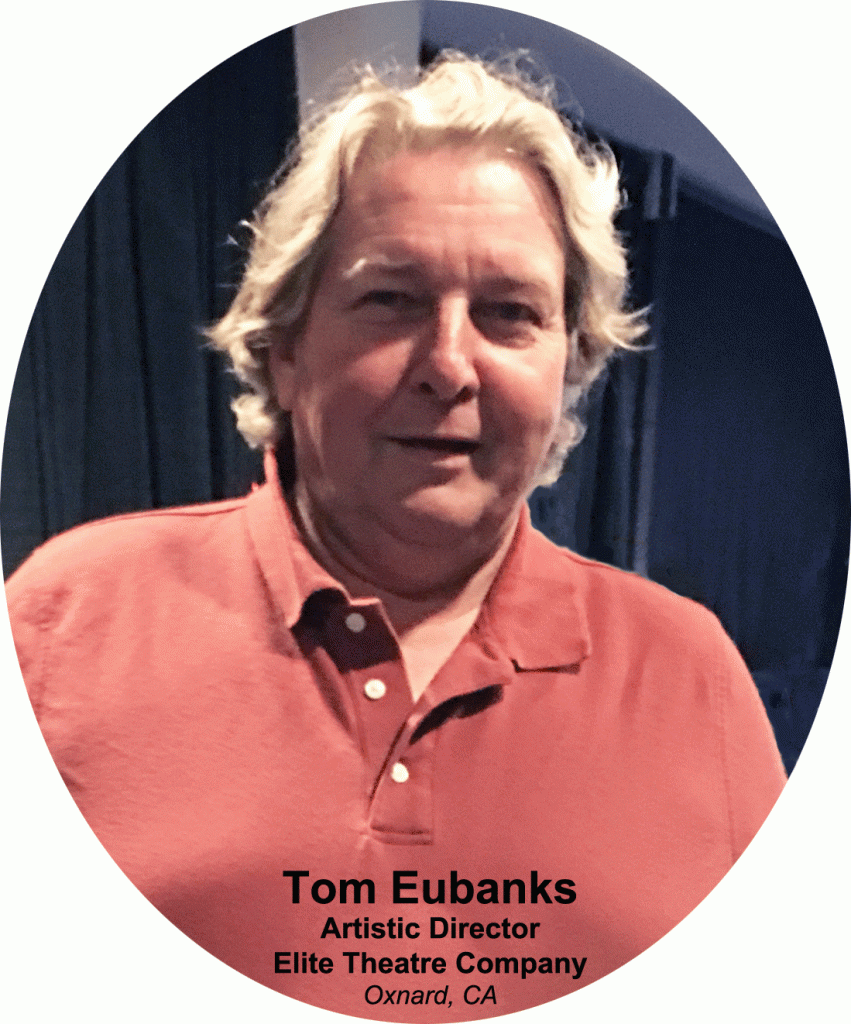
As I don’t have any photos of Tom that date to the 1990s I decided to use this image of him that I took on 13aug2016. (photo © Tom Eubanks & Louis Kraft 2016)
I believe that at this time he had already directed a number of stage productions. One night our words crossed swords over a play that he directed (and I think that he liked), The Owl and the Pussycat. Some years back I had been assigned to work on it at the Melrose Theatre Company, a professional theater group in Hollywood that I became a member of in the 1970s. I didn’t like Bill Manhoff’s The Owl and the Pussycat. Most likely because I was probably the worst Felix ever. The play focused on Doris (the pussycat) and Felix (the owl), and had some great scenes but I never came close to connecting with the character. For me, he was a pure “nothing” (Barbra Streisand and George Segal played the roles in the 1970 film version; I’ve always liked Barbra’s singing and acting, but didn’t like this film). This was not a great beginning to a potential Eubanks-Kraft friendship.
A lady in the Ventura group read the opening chapter from her novel as her character watched the panorama of spectacle and debauchery in pre-history England as it unfolded on the plain below the tree from which she saw all that happened. When I asked her the name of her major character, she didn’t know what I was talking about. I rephrased the question: “Who was the person in the tree?” “An extra.” It was my turn to be confused. “What?” “She is nobody and doesn’t need a name,” came the reply. “But everything that happened in your story has been seen through her eyes. She reacted to what she saw and is the focus of the scene. So far she is your only character, and …” “No!” “Why?” “You’ll never see her again.” … This woman was beyond help.
Nevertheless, it didn’t take me long to realize that Tom was almost always right on with his comments. He had a quick wit, was funny, and always contributed constructive comments that could benefit the writer on the hot seat if she or he listened. Better yet, a friendship began to develop.
The Final Showdown
That same year of 1990 I attended a Western Writers of America (WWA) convention in Portland, Oregon (unfortunately I didn’t bring a camera to fully 95 percent of the first two-thirds of my life and there are few images. At that time I had a literary agent (not my first for earlier I had had three screenwriting agents, and the first one—Ed Menerth (1976-1982)—took me under his wing after I submitted a fictionalized screenplay based upon my surviving a harrowing summer of dinner theater in Lubbock, Texas, in 1976.
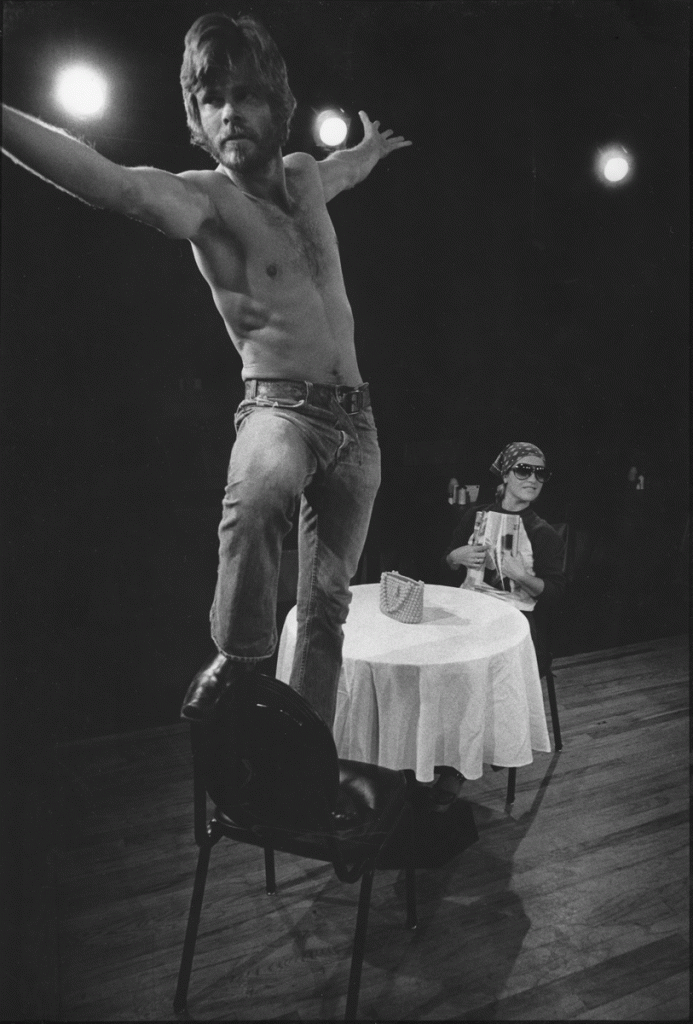
A publicity photo from the Hayloft Dinner Theatre in 1976. I was performing in the generation-gap What Did We Do Wrong in the evenings while rehearsing Eat Your Heart Out during the days (and this photo is from one of the daytime rehearsals), which was about an actor who waited tables while struggling to survive in Hollywood. That’s Robin LaValley, an LA actress in the background. I don’t remember if the leaping onto the chair was in the script or not but it was always a balancing act. This was one of at least two plays wherein I dueled with imaginary swords on stage. … With luck, one more time. (photo © Louis Kraft 1976)
Actually, I was lucky to get out of the Lone Star State without being tarred and feathered, or worse (I had lived and worked with racism and violence in Texas and Oklahoma in 1970 but the 1976 racism was worse).
Back to the 1990 WWA convention. One late night that June my then agent Cherry Weiner, Walker and Company editor Jackie Johnson, I sat in the Oregon hotel lobby sipping drinks and chatting.
I pitched a story that took place during the lead-up to the Medicine Lodge Peace Council in 1867 Kansas, the council, and the aftermath. While most of the characters actually lived (Cheyennes Black Kettle, Stone Forehead, and Bull Bear; Kiowa Satanta; reporter Henry Morton Stanley; Captain Albert Barnitz (Seventh U.S. Cavalry); and Indian agent Ned Wynkoop; the three leads were fictional. It had action, was romantic, and it dealt with Cheyenne-white race relations.
Two or three months later my agent called me. “Have you drafted three chapters?”
“What are you talking about?”
“The story that you pitched Jackie Johnson. She wants to see three chapters.”
Sometimes I’ve got a few screws loose in my brain. “I didn’t realize that she was interested.”
“She is. Get on it!”
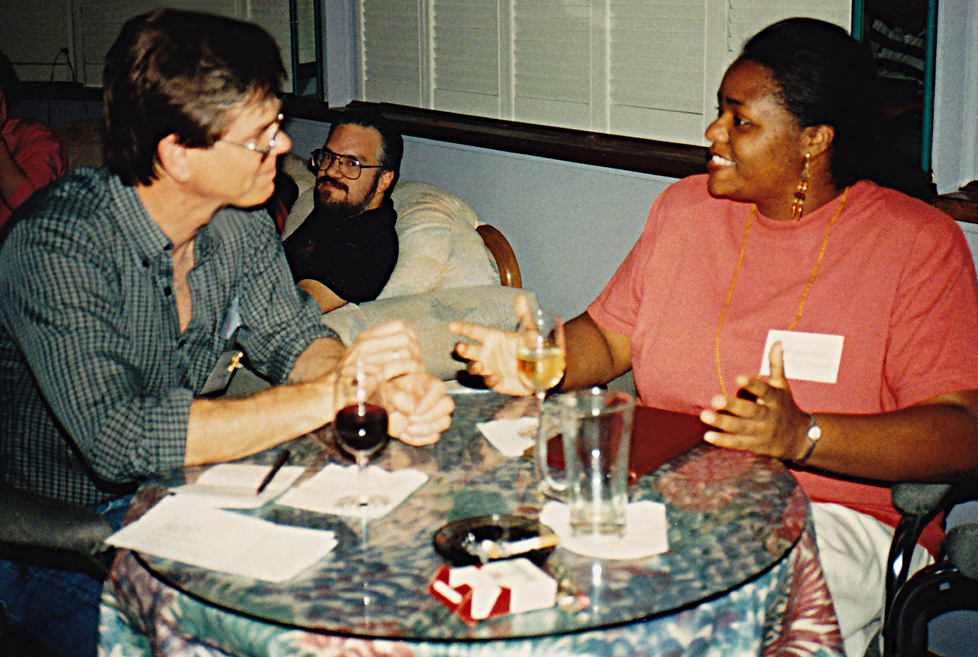
LK and editor Jackie Johnson chatting at the 1991 Western Writers of America convention. (photo © Louis Kraft 1991)
It took me a couple of months to draft the requested chapters, and as I wrote I presented at the weekly meetings of the fiction group. Tom, and others, helped me immensely. I received a contract on those three chapters.
|
The lead players in The Final Showdown I based the three fictional leads on real people. Ex-soldier Ned Morgan, who had been at the 1864 Sand Creek Massacre in Colorado Territory, was based on Wynkoop* (while never calling the real Wynkoop “Ned” and referring to him as “The Tall Chief Wynkoop,” which I steer clear of in my nonfiction writing); I used the famed Northern Cheyenne war leader Roman Nose as an inspiration for The Wolf’s Head; and a lady friend I once knew for Elsa Wells (she read and liked the book, but never realized that I had pulled from her inner being to create Elsa). … Here’s a warning to my lady friends: Be careful with what you share with me as you might become inspiration for one of my fictional female characters, and often they are on the adventurous side. * The real Wynkoop was not at the Sand Creek Massacre. |
This placed Tom front and center with Wynkoop from almost the beginning as I moved between various media time and again as I struggled to figure out who he was. Tom would eventually see some of my articles about the soldier turned Indian agent but never heard any of my talks that dealt with him.
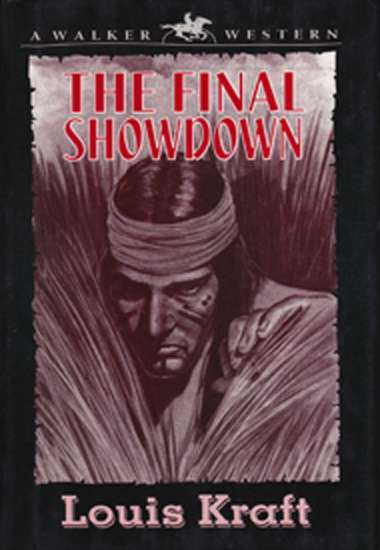 By fall 1991 The Final Showdown was at the publisher’s in New York City. Everything should have been good.
By fall 1991 The Final Showdown was at the publisher’s in New York City. Everything should have been good.
Unfortunately it wasn’t for my marriage was limping toward its end. My time in Thousand Oaks ended a month or two before the divorce was final in early April 1992, and it marked the beginning of the end of my membership with the Ventura writing group. When I moved my belongings to an apartment in Tarzana, a town in the San Fernando Valley (Los Angeles city and county), Tom Eubanks played a major role in getting my handful of belongings back to LA and safety.
Instead of this disaster marking the end of my friendship with Tom, it marked the beginning.
Before the divorce was final the publisher had submitted the book to the Thousand Oaks News Chronicle, and a staff writer called me at Infonet (now British Telecom Infonet) in El Segundo, California, to interview me. He wanted to come to the Thousand Oaks house. I told him that I worked as a technical writer in the South Bay, which is south of Los Angeles International Airport (LAX), and that I had a two-hour drive each way (all true), and that I’d prefer a phone interview. He was good with this, called back twice, and we spoke for perhaps three hours.
Before hanging up the last time we spoke the reporter told me that a photographer would visit me at my home. “Why does it have to be at my home?” I asked. “You must live in Ventura County; if you don’t, there won’t be an article,” he snapped. “Do you live in Ventura County?” “Of course!” I gave him my former address and we set a time for the photo shoot the following Saturday.
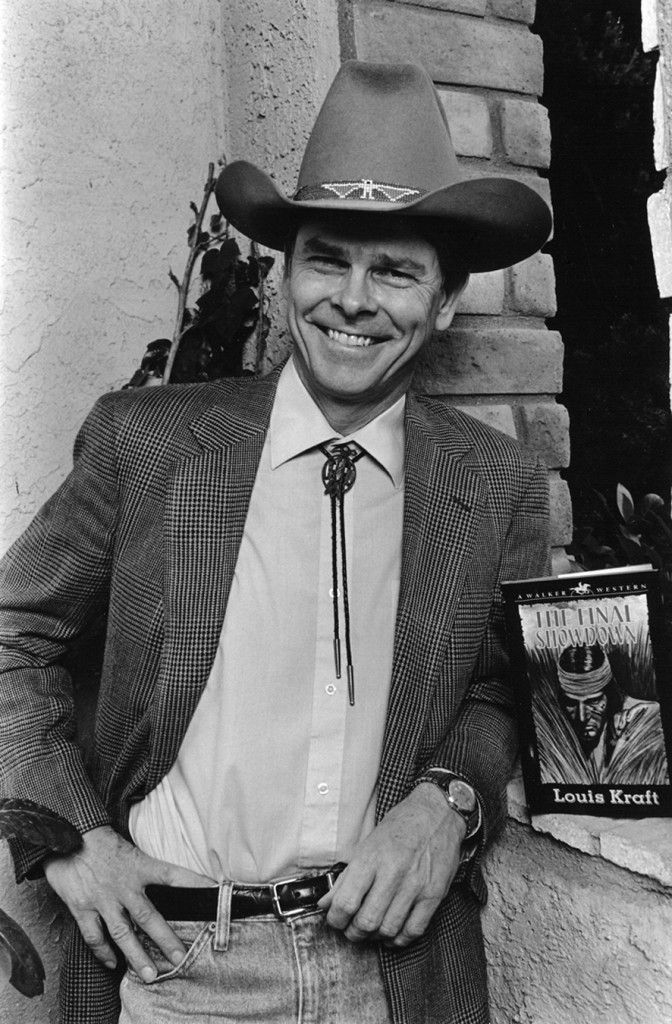
LK in the courtyard entry to the Thousand Oaks house in April 1992. Photo used by permission of the Thousand Oaks News Chronicle.
I called my ex-wife, explained the situation, and asked if the paper’s photographer could take photos at the Thousand Oaks house. “Yes,” she said, “as long as you don’t come inside.”
When the photographer arrived at my former home I met him in the front yard. After leading him into the courtyard and suggesting an archway opening that I thought would make a great photo, he agreed, set up his lights, and snapped away. He then suggested that we go inside and shoot photos of me at my computer. (Oh horror or horrors!) “That’s a terrible idea,” I said (yes, I did prep for what I could not let happen). “Why?” “Do you take photos of all the authors your paper writes about sitting at their computers?” “Yes.” “Well, damn, by now that is cliché.” He agreed and I began to breathe again.
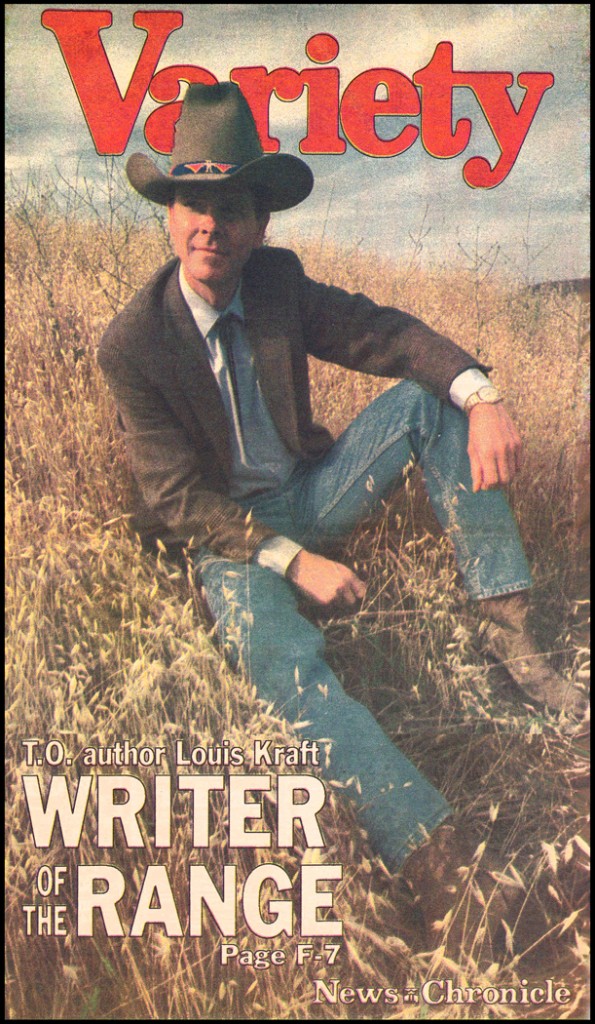
The cover page for the Thousand Oaks News Chronicle “Variety” section. LK is sitting near the top of the hill to the west of the 101 Freeway. This is the image that saved the interview.
I suggested a hill on the west side of the California 101 Freeway after exiting at Lynn Road. He agreed, we drove to the hill, climbed it, and luckily we got the images he needed. … I later called my ex-wife and thanked her, and that call was from my heart.
Tom’s Plays and the passage of time
As said above, my move to Tarzana ended my days as a member of the Ventura County writers group as it was just too far to drive, and especially as my days at Infonet began at 6:00 AM. Of great importance my relationship with Tom didn’t end. He began inviting me to see his plays at the Ohai Art Center Theatre in the Ohai Valley (Ventura County, Calif.), and our friendship grew. He had a wide range of plays that he directed, from the famous (such as Equis) to the not-so-famous (can’t think of an example) to plays he wrote. Yes, Tom is a terrific writer; fiction and plays, and over the years the number of plays that he has written has grown considerably. I’ve seen a lot of them, and they are damned good. I’ve not asked, but I hope that other directors have staged some of his plays.
I met Tom’s wife, Judy, in those wild early years of the 1990s and from the moment that we first met I’ve always enjoyed spending time with her. Tom has three daughters, Cassie, Alex, and Hannah (who’ve I’ve known since she was an infant). … I have more to say about Tom, for not only is he a bright fellow who does a great job of bringing his writing and plays to fruition, he’s open, friendly, generous, and funny with a very quick wit, but probably best of all he is a wonderful husband and father. Judy and his daughters are lucky to have him.
The years passed and I enjoyed our friendship at his home in Casitas Springs and at Tujunga House (which became my home in January 1993).
A trip to Yuma & its importance
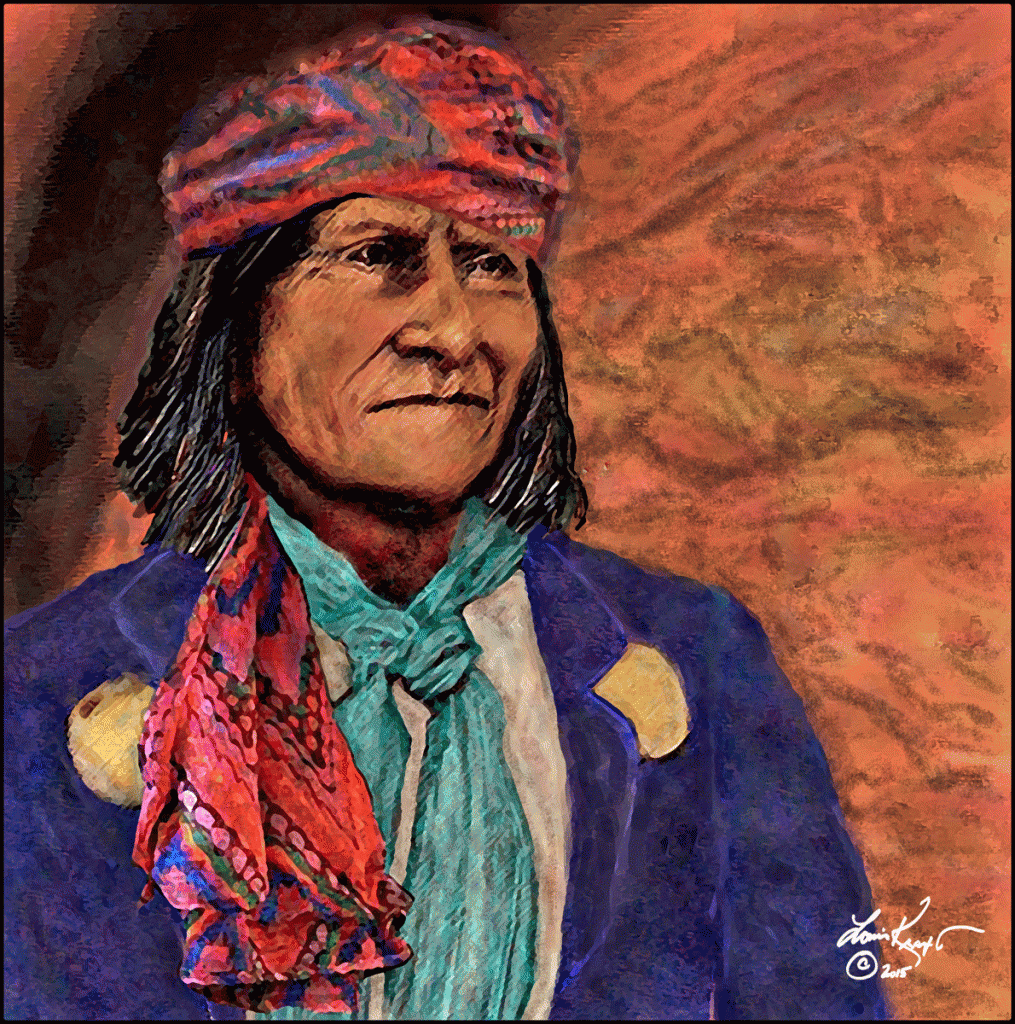
LK art of Geronimo (© Louis Kraft 2015). This art was accepted by Greg Lalire, great editor for Wild West magazine in 2015. By summer 2022 Greg had been editor of the magazine for 33 years. He was let go in fall 2022, with three-weeks severance pay, as the slimball company that had bought the roughly 12 or 13 history magazines in 2015 (and had decided not to use my art) decided to cut back on costs. Some, if not all of the magazines, are now published quarterly by a skeleton crew with a new editor who should have never obtained this position (you do not want to hear my view of this person who mostly cites clichéd books that do little or zero research—right up his alley, for neither does he). I will never write for this organization again and will never purchase or read another of their publications. Geronimo was a magnificent Chiricahua Apache war leader and mystic. I removed my G&G book cover from this blog (on 1nov2022) as I wanted to say some words about this heinous Wild West magazine action.
I’ve been to Yuma, Arizona, twice, and this section deals with the first trip.
In 2000 Gatewood & Geronimo was published, and I delivered a number of talks. One was in Yuma.
LK art of Geronimo (© Louis Kraft 2015). This art was accepted by Greg Lalire, great editor for Wild West magazine for 33 years until he was dumped in fall 2022, as the slim ball company that had bought the roughly 12 or 13 history magazines in 2015 decided not to use it for my cover story on this magnificent Chiricahua Apache war leader and mystic. I removed my G&G book cover from this blog (on 1nov2022) as I wanted say some words this heinous action. Do not read any more of the current owner’s magazines (some if not all are now published quarterly by a skeleton crew and Wild West’s new editor should have never obtained this position (you do not want to hear my view of this person who mostly cites clichéd books that do little or zero research—neither does he). Enough said, other than to say that I will never write for this organization again and will never purchase or read another of their publications.
All I can say about this place is that it’s hotter than Hell during the summer months. On this first trip I spoke about 1st Lieutenant Charles Gatewood finding Geronimo in Mexico and talking him, Naiche, the last hereditary Chiricahua Apache chief, and the people with them into ending the last Apache war. The book had just been published and the two maps were an assembly of dots and totally useless. I was told that in the blue line the maps were fine. I replied that this was bullshit (I had seen too many blue lines to doubt my view sight unseen), and I must have been correct for the publisher recalled all the books (and it had been printed in hardback and paper at the same time; a costly mistake). BTW, I never saw this blue line until years later when it was sent to me, and it proved that I was right in 2000—the maps were a disaster and no one at the press had checked the blue line. I quickly forwarded it to the Louis Kraft Collection in Santa Fe, New Mexico, but I don’t know if the archive kept it or trashed it (hopefully the former).
I had been thinking about writing a one-man play and had already outlined one on George Armstrong Custer. But during the drive home from the talk in Yuma I began thinking about Ned Wynkoop, who had gone from being a racist to someone who accepted Cheyenne and Arapaho people as human beings. Ladies & gents, I hate to say it but this is still a major problem in the USA 150+ years after Wynkoop decided to live by his conscience and damn all who disagreed with his choice.
For the record this is my choice. A good person is a good person, and I don’t
give a bleep what his or her color is, where they were born, or what their race or
religion is. We are all human beings living on earth by the grace of God.
This didn’t happen until Wynkoop, as a major in the First Colorado Volunteer Cavalry, attempted to end the 1864 Cheyenne war when he without orders and at great risk to himself and his men, rode to a tributary of the Smoky Hill River in Kansas to discuss ending the war with Cheyennes and Arapahos.
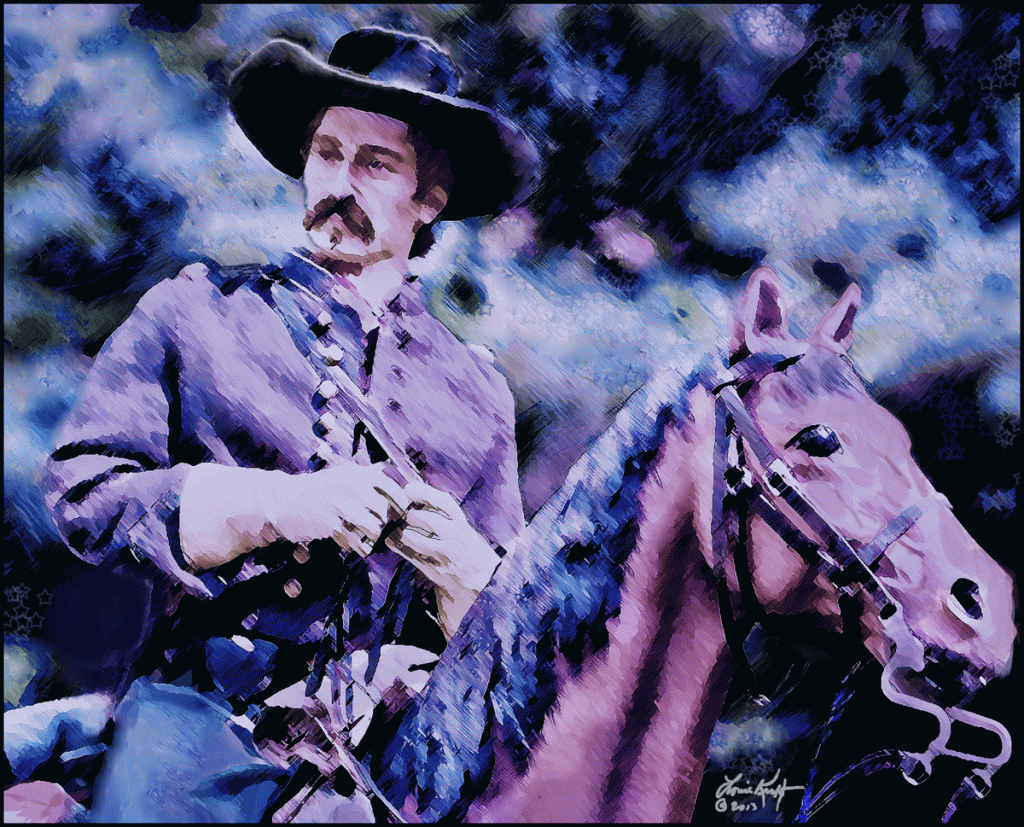
While traveling to the still unseen Cheyenne and Arapaho village on a tributary of the Smoky Hill in western Kansas Wynkoop’s small command was confronted by a battle line of perhaps 700 Cheyenne and Arapaho warriors on 10sept1864. Original art © Louis Kraft 2014, and first published in “Wynkoop’s Gamble to End War,” August 2014 Wild West magazine.
As stated in the image caption above Wynkoop was confronted by a battle line. No violence happened at the confrontation and later that day he met in council with Cheyenne and Arapaho chiefs in a grove of trees (he never saw the huge village of 2,000 people). Although threatened and at times in a desperate situation he would eventually receive four children prisoners and was able to talk seven Indian leaders into traveling with him to Denver, Colorado Territory, to discuss ending the war with Territorial Governor John Evans (the council eventually took place at Camp Weld, just south of Denver).
Wynkoop and the Indian leaders thought that peace had come to the land. They were wrong. Wynkoop was removed from command at Fort Lyon (Colorado Territory), and Cheyenne Chief Black Kettle and Arapaho Chief Left Hand moved their villages from the post and to Sand Creek, about 40 miles to the northeast. Wynkoop traveled to Kansas, where he expected to be cashiered out of the military for being absent from his post in time of war (without orders he met the Indians on the Smoky Hill and brought them to Denver). Three days after Wynkoop set out for Kansas Colorado Volunteers attacked Black Kettle and Left Hand’s villages—villages that thought that they were under the protection of the U.S. military until it decided to end or continue the war.
What happened on that tragic November 29, 1864, day rips me apart every time I think about it.
On that drive home from Yuma I conceived a one-man play on Wynkoop and the Sand Creek tragedy. I called Leo Oliva, a Kansas historian and friend who played a major role in the Fort Larned Old Guard, an organization that deals with the history of the Fort Larned National Historic Site (NHS), and pitched the idea. For years Leo had been instrumental in bringing me to Kansas, and nothing had changed. He loved the proposal and said, “How about next April.” Although thrilled I had to say, “No,” as I didn’t have an outline, a play, or a director. “How about April 2002?” I offered. … It was a go.
I pitched the idea to Tom and he liked it.
Wynkoop one-man shows in Kansas, California, Colorado, and Oklahoma
As said above not many photos were taken but by the early 2000s a change was a comin’.
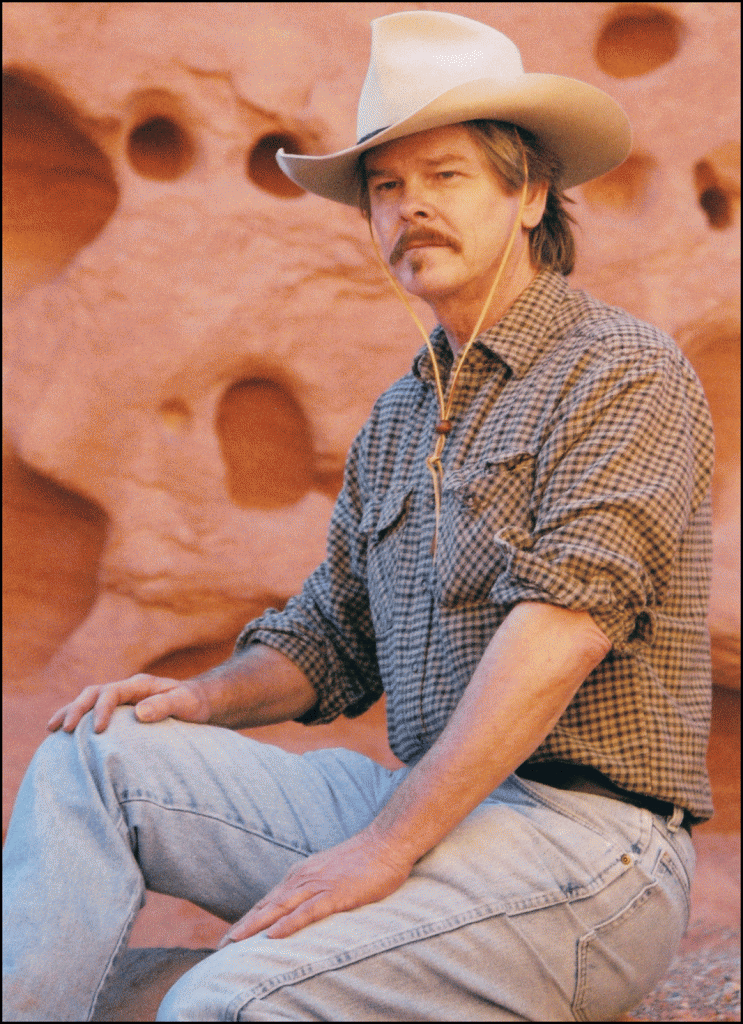
The image I sent Leo Oliva. (photo © Louis Kraft 2001)
Taking a one-man show on the road is not a cup of tea; it is 14-or-more-hour days as a set needs to be created, lights need to be set, and technical rehearsals need to happen. If anything can go wrong, I guarantee that it will.
As 2001 neared its end Leo Oliva requested a publicity photo of me as Wynkoop. This was impossible as the hat and costume were still being made. However, that November I spent some time in Nevada and had some photos taken at the Valley of Fire State Park, northeast of Las Vegas.
I printed it and sent it to Leo, and it was subsequently printed on the cover of the Fort Larned Old Guard newsletter, Outpost, promoting An Evening with Ned Wynkoop.
Of course it garnered me a complaint from California historian Eric Niderost. “Wynkoop didn’t dress like that!!!” he snarled.
“No shit, Sherlock!” Publicity with a photo is always better than publicity without a photo.
As soon as I had the costume (a wife of a former superintendent of Fort Larned created it for me) and hat I took some photos at Tujunga House and sent them to Leo Olvia, but I don’t believe any were used in the publicity.
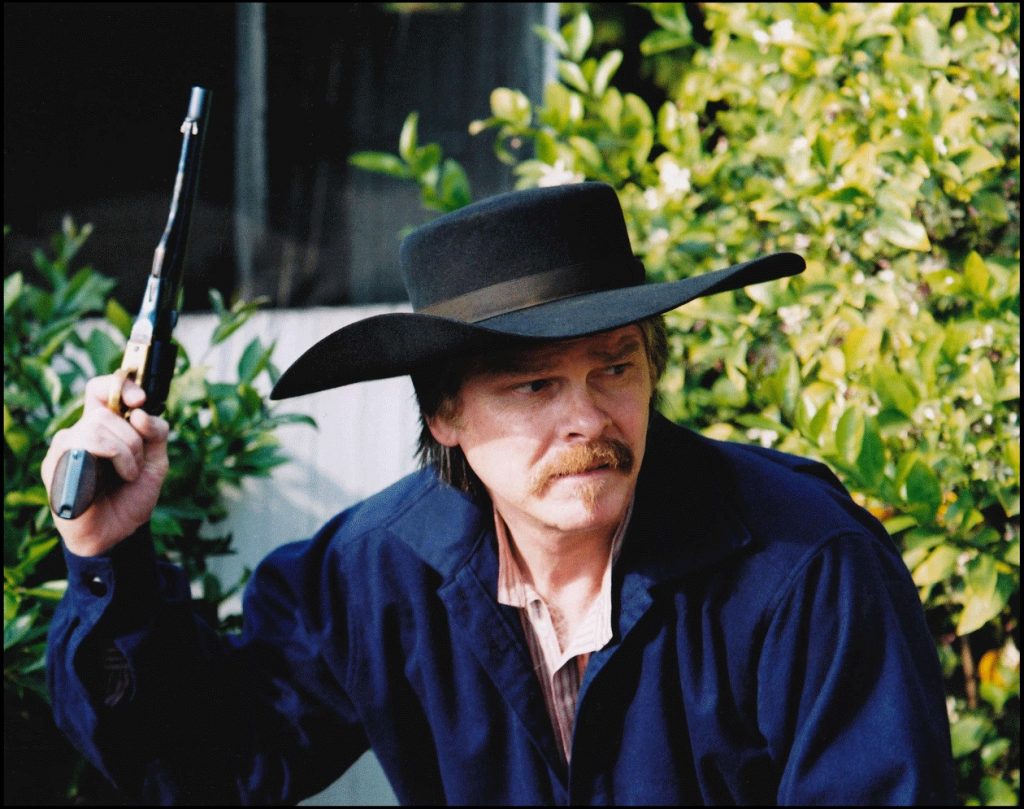
I’ve always liked this image that was taken in front of a shed that no longer exists at Tujunga House. Baron Hats (Burbank, Calif.) made the hat for me (it is based upon the hat that Wynkoop wore in a 1867 woodcut that appeared in Harper’s Weekly in May of that year). They make a lot of the hats used in films, and since this hat they have made all of my hats. I didn’t include this image in the package that I had sent to Leo Oliva. (photo © Louis Kraft 2002)
Kansas
I first traveled to Fort Larned, Kansas, in 1990 for The Final Showdown research. On that trip I met (now) chief historian George Elmore, who has been my friend since we met. I can’t begin to tell you how much he has done to help my Indian wars writing over the years.
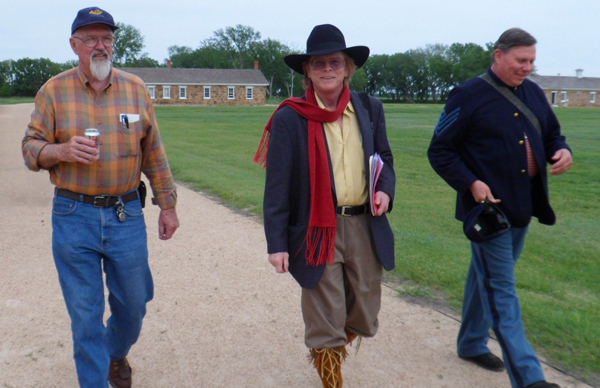
I think that this picture is the only photo I have of George Elmore (right), Leo Olvia (left) and me together. We are walking on the Fort Larned parade ground. The photo, by National Park Service ranger Ellen Jones, dates to the morning of 28apr2012 when I was a banquet speaker at the annual Fort Larned Old Guard conference.
For the record I don’t get stage fright (acting or talks), and I guess that this comes with the number of performances and talks over the years. If true, the talks, which have been prepped are script-less, and by that I mean that although I know what I’m going to talk about I don’t memorize while at the same time I work at getting a flow to the talk (the only things I memorize, that is try to memorize, are quotes). Glitches happen, and over the years I’ve learned how to deal with them as best as possible.
But the one-man show would be different. Both Tom’s and my ass were on the line. If the worst happened I’d be standing alone on stage while Tom ran for the closest exit. Luckily this scenario has never happened as each time Tom has pulled off a miracle: Getting a set built, lights set, and when people volunteered or were assigned to run lights and sound weren’t technical and were placed in a difficult situation he coached them until they were able to pull off the impossible.
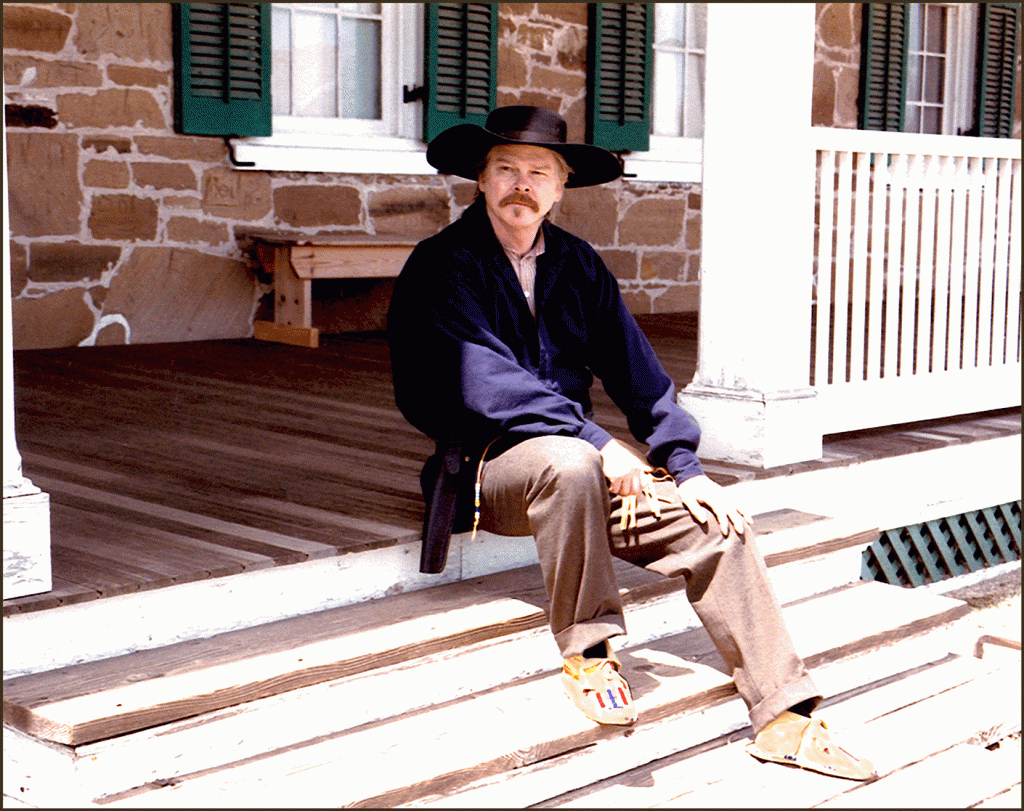
LK enjoying Fort Larned while dressed as Ned Wynkoop in early May 2002. (photo © Louis Kraft 2002)
The day before Tom arrived I dressed in the Wynkoop costume and my then girlfriend and I hung out at the fort (doing a little living history) and took a series of publicity photos.
The city of Larned had a huge and first class proscenium theater (it seated at least 2000), but although we requested skilled light and sound technicians we were given two people—kind and giving ladies—that were clueless. Read long-long hours (from roughly eight each morning until after midnight) of getting the lights angled and set, and after learning how to run the complicated light and sound board Tom had to teach the ladies how to perform their cues. … George, Leo, and a number of Fort Larned’s maintenance crew built platforms to Tom’s specifications, built a stool which also substituted as a horse, built a podium, and rounded up the requested log, desk, and chair, and delivered everything to the theater on the morning after Tom’s arrival.
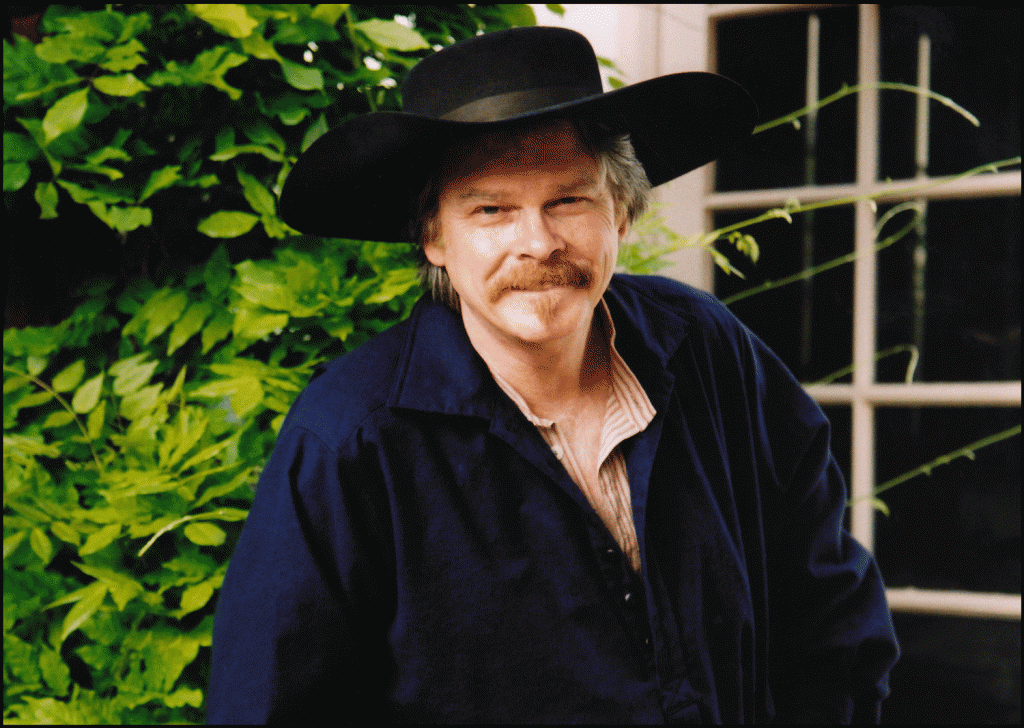
I had recently used a very tight cropping of this photo elsewhere on social media. The reception had been surprisingly good and I decided to use the uncropped image here to hopefully mellow my rambling. (photo © Louis Kraft 2002)
Pure hell for LK, for as the hours passed (I think that we had three days to pull it off), I didn’t have a technical or dress rehearsal. I was on the stage at all times, and basically functioning as my own stand-in. As showtime neared, and I didn’t have any rehearsal other than getting familiar with the set and mumbling my lines under my breath, only to again and again stand or sit in a specific location for technical issues.
My apologies for complaining
but Tom and I had put in a lot work in California just to get
ready to travel to Kansas. The time was short. Tom, with the generous
support of George Elmore, Leo Oliva, and others connected with Fort Larned,
pulled off nothing short of a miracle to create a set, angle lights (Tom), and set
the sound and light cues (Tom). From then on everything was related to the technical
end of getting the two volunteers to learn how to run the lights and sound.
I needed at least one complete rehearsal on the real set and
there hadn’t been any since arriving in Kansas.
I did have my dress rehearsal just hours before showtime.
I was miked as the show was presented in a huge auditorium. … During my only run-through of the play the mike fell from the costume and slid across the stage. The rehearsal continued without the mike while not missing a beat, but I was well aware of what could happen. Luckily when we had an audience everything went soothly on stage (and I presume in the sound and light booth).
California
Soon after we were both back in California (I had driven while he had flown to Kansas) Tom asked if I’d like to take Wynkoop to Ohai. You bet, for I had always wanted to act on the Ohai Art Center Theatre stage.
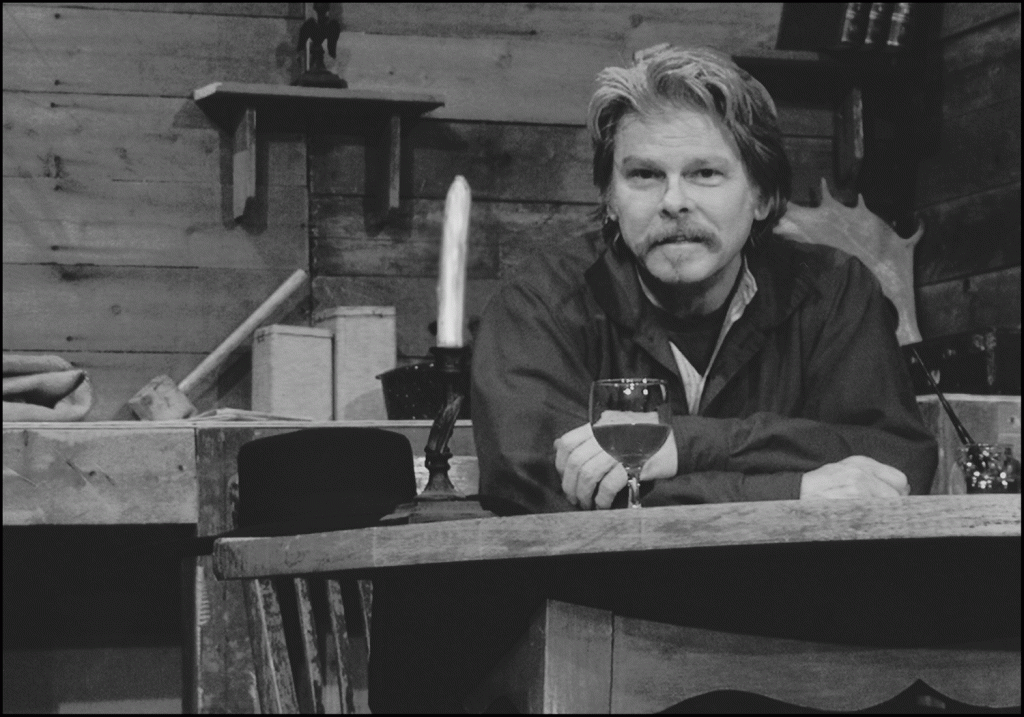
This photo of LK as Wynkoop sitting at his desk was taken at the Ojai Art Center Theatre by the Ojai Valley News in May 2002, and is used by permission.
Tom, who was the artistic director, slipped An Evening with Ned Wynkoop between major productions. He used an incomplete set (partially seen in the above photo) and had platforms built to his set-design specifications. As in Kansas a log represented an Indian village, a podium New York City, and so on. Again we had proscenium stage but much more actor friendly (120 seats, 150 seats?). Much more intimate, which I prefer. An Evening with Ned Wynkoop played in Ojai in June 2002.
Colorado
Next up was Colorado, and I rewrote the play—now called Ned Wynkoop: A Matter of Conscience—to focus a little more on the horrific 1864 attack on the Cheyenne-Arapaho village, a tragedy that has still not healed for these people. The former Colorado Historical Society* (CHS) had a huge auditorium and they guaranteed to fill all 400 seats.
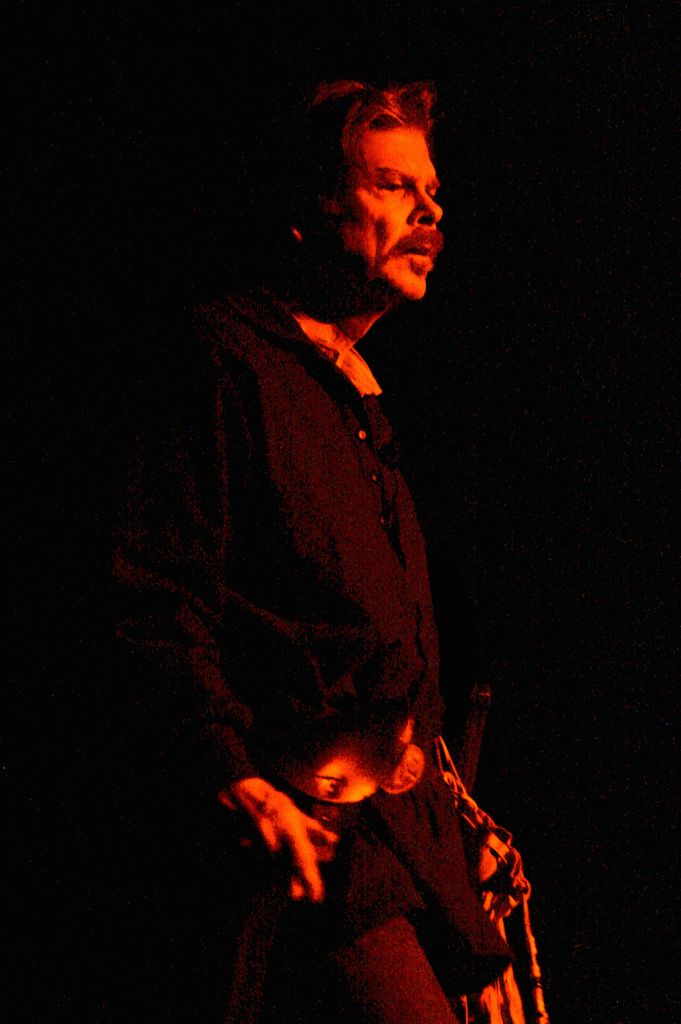
LK as Wynkoop seeing the remains of the Sand Creek dead for the first time months after the 29nov1864 butchery. Pal Johnny D. Boggs (a writer, editor, and photographer) took this image at a December 2008 dress rehearsal in Oklahoma. I have no images from the performance in Colorado. I believe that it was in Colorado when Tom lit this scene in red for the first time. … At the end of the Sand Creek scene I knelt down at stage right as close as I could get to the audience to look at what was left of a Cheyenne girl and as Wynkoop said: “I couldn’t believe what I saw. This wasn’t the savagery of animals—what stared at me was the creativity of civilized man. This was the work of my compatriots, … of white men. … What I saw could have been Louise—could have been my children.” (LK: Louise was Wynkoop’s wife.)
Again, it would be another challenge taking the show on the road, but a friend, Anita Donotello, whom I had met in El Segundo, California, when I spoke at one of Dick Upton’s symposiums (miss them), volunteered to run the lights and sound. Doable as she had moved to Colorado. She was right there with us every step of the way; doing everything, including driving us everywhere and functioning as Tom’s go-to assistant. After the show ended and Tom flew home I stayed at her house for another week while I did Wynkoop research at the Society and at the Denver Public Library. As I had worked out a deal to remain in the terrific hotel room that the Society had provided Tom and me, I had some leverage with Anita. I told her that I’d gladly accept her invitation if she invited Indian wars historian Jerry Greene over for a dinner that I’d cook. I didn’t know Jerry, wanted to know him, and knew that they were friends. I got my way and the four of us, which included Anita’s son Nicholas, enjoyed our evening together.
Again I think that we had three days (but it might have been two) to create the set and deal with the technical aspects. This trip wasn’t as frantic as Kansas as Robyn Jacobs, the CHS Adult Public Program Coordinator, was on top of everything (and she had a budget). She had even ordered metal frames to build a multi-leveled stage. Tom had come up with a great log to represent the Cheyenne village but an inspector or Society bigwig saw it and demanded that it go because of the threat of termites. I don’t know what Tom said, but the log stayed.
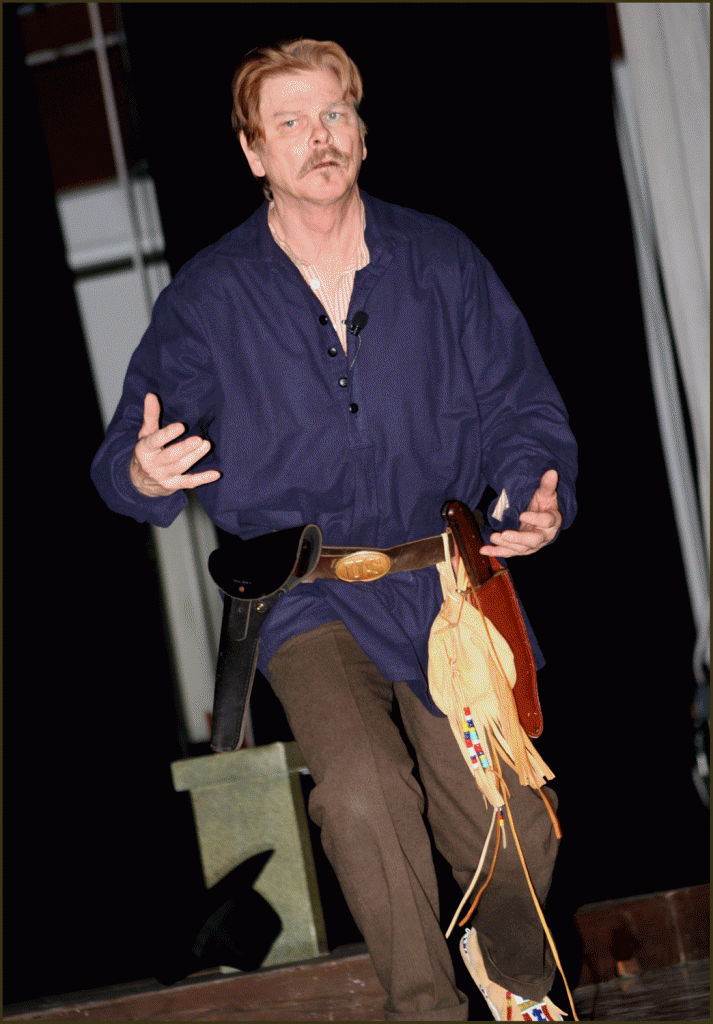
Near the end of the play events in Wynkoop’s life began to haunt him when he was ordered to Indian Territory to collect his Indian wards at an area designated by the military. As he traveled through deep snow in November 1868 he sensed another massacre. Suddenly he thought he saw Isabelle Eubanks, a three-year old girl he received from the Cheyennes in 1864. He yanked the wagon to a halt and ran to comfort her, but couldn’t for she changed into the Cheyenne girl who had been raped again and again by soldiers at the Pawnee Fork in 1867 Kansas. … It couldn’t be, for both were dead. Alone, he needed to make a decision and allowed his conscience win out. Photo by Johnny D. Boggs in 2008.
Better, Tom and I had time to enjoy great breakfasts at the hotel, one lunch during our first day in town, and a great dinner after the show closed.
Sometime during our time in Denver I had proposed adding a scene for fun when Wynkoop, as the lead in The Drunkard (which garnered him great reviews in Denver), struggled trying not to take a drink at a climatic moment in the play. We rehearsed it and Anita (or Annie as Jerry calls her) was good with the last minute insertion. Both the technical rehearsal and the dress rehearsal went smoothly the morning of the performance. After notes Tom and I retired to our hotel room to relax.
Due to the low hanging lights that Tom had to use to light the stage I could see the audience. This wasn’t a problem as I couldn’t make out details, and even the faces of those in the first three rows were little more than blurs. This has always been a blessing for me and certainly has helped me keep my concentration, which is of major importance.
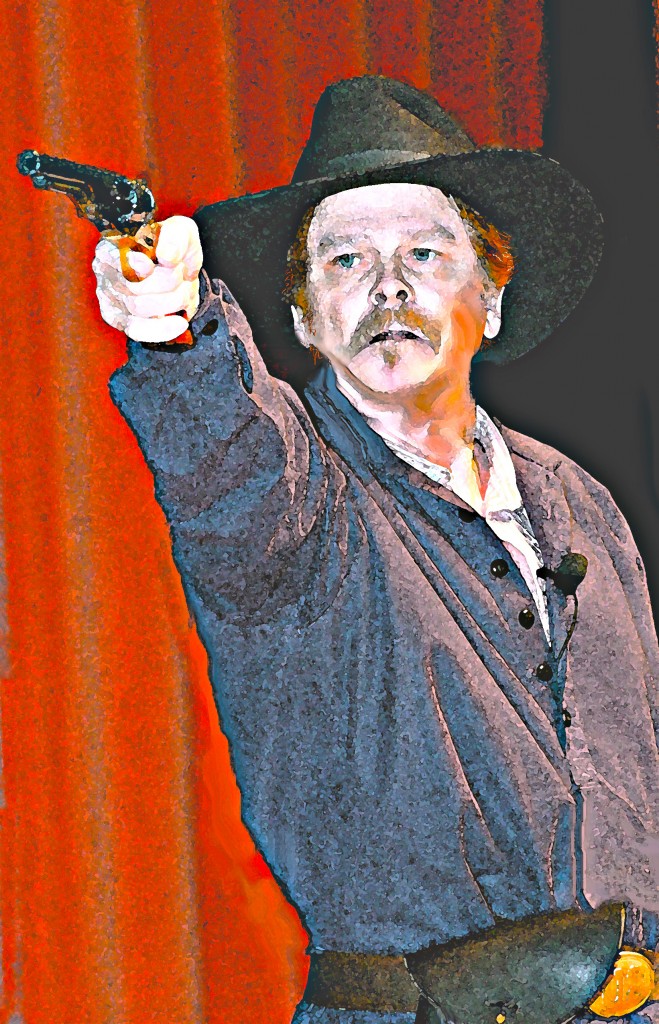
I based this illustration on one of the photos that Johnny D. Boggs took of me in Oklahoma. … And, yes, it illustrates that moment when LK/Wynkoop took deadly aim at a CHS patron that was sitting at stage right because the Society decided not to turn away walk-ins on the night of the performance. Am not complaining, for I loved this audience. (art © Louis Kraft 2008)
The show ran smoothly and I had an absolute blast playing to 440 people (40 over the seating limit). Some of the overflow sat in the side aisles and the rest stage right, which was fine as I played to them too. One problem occurred when I yanked out the 1860 Army Colt and pointed it with deadly intent. Instead of aiming at an invisible enemy I now had a CHS patron in my line of fire. Oops! A quick jerk of the wrist and the revolver pointed upstage right. … For the record I swept right by the Wynkoop drunk scene without missing a beat. Afterwards Anita teased me, saying something like: “It’ll make the next show.” All I could do was shrug and agree. … It didn’t matter for I had had one hell of a good time.
Mike Koury (Order of the Indian Wars & The Old Army Press) has been a terrific friend since we both spoke at an Indian wars conference in SoCal in February 1987. He said he planned on seeing the show, and it was great seeing him afterwards.
Tom and I ate a great dinner at a restaurant on the walk back to the hotel (we passed the restaurant twice each day, and this dinner was planned). A good time as we chatted and enjoyed our food and drinks. I hated that the evening was coming to an end, but then I’ve always had good times with Mr. Eubanks.
* Sometime in late 2011 or 2012 the Colorado Historical Society became History Colorado and moved into a spectacular modern building a block away.
Oklahoma
A few years passed and I gave a talk about Ned Wynkoop and Cheyenne race relations at a 2007 Western History Association convention in Oklahoma City. The session was Indian wars-based and the three speakers enjoyed a standing-room only audience with another 12 or more people lining the back wall or struggling to listen and see from the doorway.
Afterwards, Dave Schafer, then chief of interpretation and operations for the Washita Battlefield National Historic Site, and his wife Valerie (who also worked for the Park Service) along with Richard Zahn and Drew Hughes (NPS rangers) in Oklahoma caught up with me after the session ended.
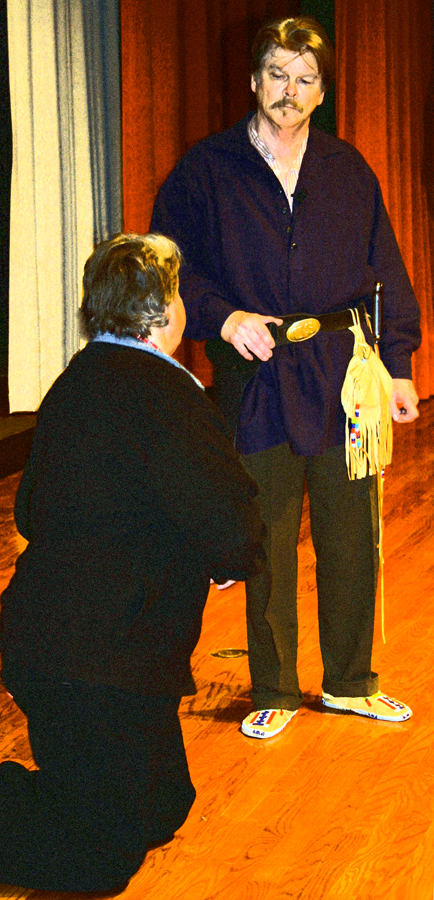 Dave and the others liked the talk and wanted to know if I’d like to present at the Washita Battlefield. Of course I would, but as we walked my mind raced. I wanted the talk but I also wanted to do an updated version of the Wynkoop one-man show. I pitched both and Dave bought both. I’d perform Ned Wynkoop: Long Road to Washita on two days and talk about him on the last day of the festivities that marked the 140th anniversary of the battle that resulted in Cheyenne Chief Black Kettle and his wife Medicine Woman Later’s deaths on 27nov1868 when Lieutenant Colonel George Armstrong Custer and the Seventh U.S. Cavalry attacked and destroyed his village in what is now southwest Oklahoma.
Dave and the others liked the talk and wanted to know if I’d like to present at the Washita Battlefield. Of course I would, but as we walked my mind raced. I wanted the talk but I also wanted to do an updated version of the Wynkoop one-man show. I pitched both and Dave bought both. I’d perform Ned Wynkoop: Long Road to Washita on two days and talk about him on the last day of the festivities that marked the 140th anniversary of the battle that resulted in Cheyenne Chief Black Kettle and his wife Medicine Woman Later’s deaths on 27nov1868 when Lieutenant Colonel George Armstrong Custer and the Seventh U.S. Cavalry attacked and destroyed his village in what is now southwest Oklahoma.
The image (right) is based upon a photo that Johnny D. Boggs took during one of the final dress rehearsals for Ned Wynkoop: Long Road to Washita in December 2008. That’s director Tom Eubanks on his knees begging LK to remember his lines. I like this description but, alas, ’tis not true. He was discussing the prayer at the end of the play, and as you can see my nose was red. Yep, LK was doing some crying. Tom was showing me how I could improve the scene.
George Elmore kindly lent me an 1860-period revolver for the performances, and saved me the hassle of dealing with the airlines, which is no fun.
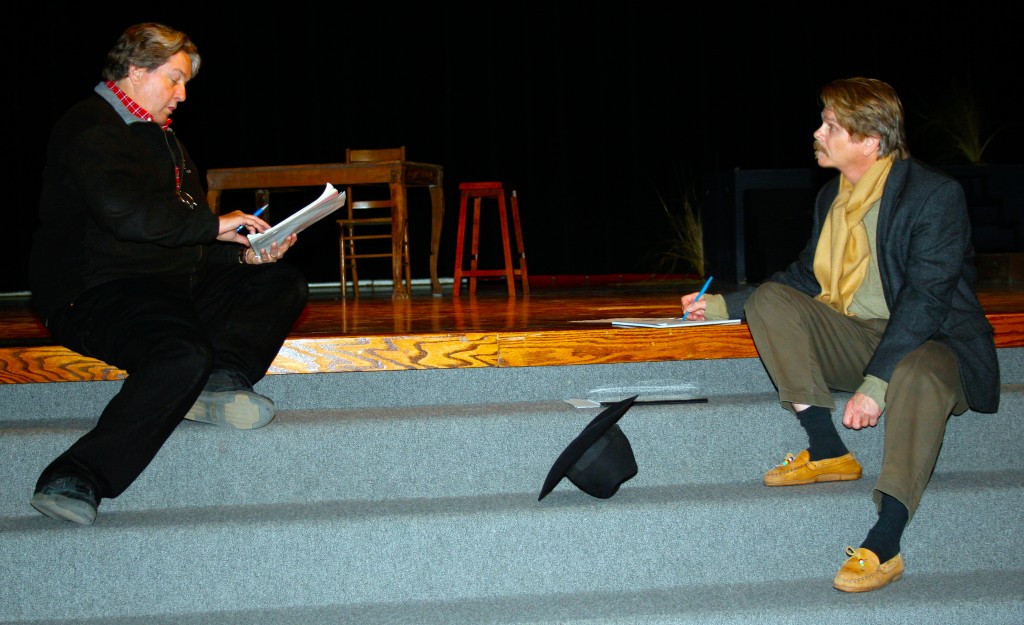
Tom Eubanks (left) and LK going over Tom’s notes after one of the dress rehearsals in December 2008. Photo by Johnny D. Boggs.
Tom and I had two performances in a huge proscenium theater in the Cheyenne High School, and there were no problems for the school provided technicians that knew what they were doing.
A great time for me for I cemented my friendship with some Cheyennes, including Minowa  Littlehawk (who would later become a godsend when she helped me with the Cheyenne words I used in Ned Wynkoop and the Lonely Road from Sand Creek, OU Press, 2011) and Dr. Henrietta Mann (one of the founders of the Cheyenne-Arapaho Tribal College in Weatherford, Oklahoma).
Littlehawk (who would later become a godsend when she helped me with the Cheyenne words I used in Ned Wynkoop and the Lonely Road from Sand Creek, OU Press, 2011) and Dr. Henrietta Mann (one of the founders of the Cheyenne-Arapaho Tribal College in Weatherford, Oklahoma).
LK as Wynkoop (left) seeing the butchered remains of the Cheyenne and Arapaho people at Sand Creek months after the tragic event. It was evident that children were shot in the top of their heads, that sexual organs had been hacked off bodies for trophies, and, although Wynkoop probably did not see the body, a soldier had cut an unborn baby from its dead mother’s womb. This is my favorite image from the Johnny D. Boggs December 2008 photo shoot.
| In the pictured scene (above) LK as Wynkoop described what he saw: “Bodies littered the ground. All were at hideous angles, … naked, … frozen in time. I dismounted and walked toward the carnage. … What I saw ripped at my guts and I had to struggle not to vomit. Wolves had come and feasted, but their hunger didn’t obscure what had come before.” |
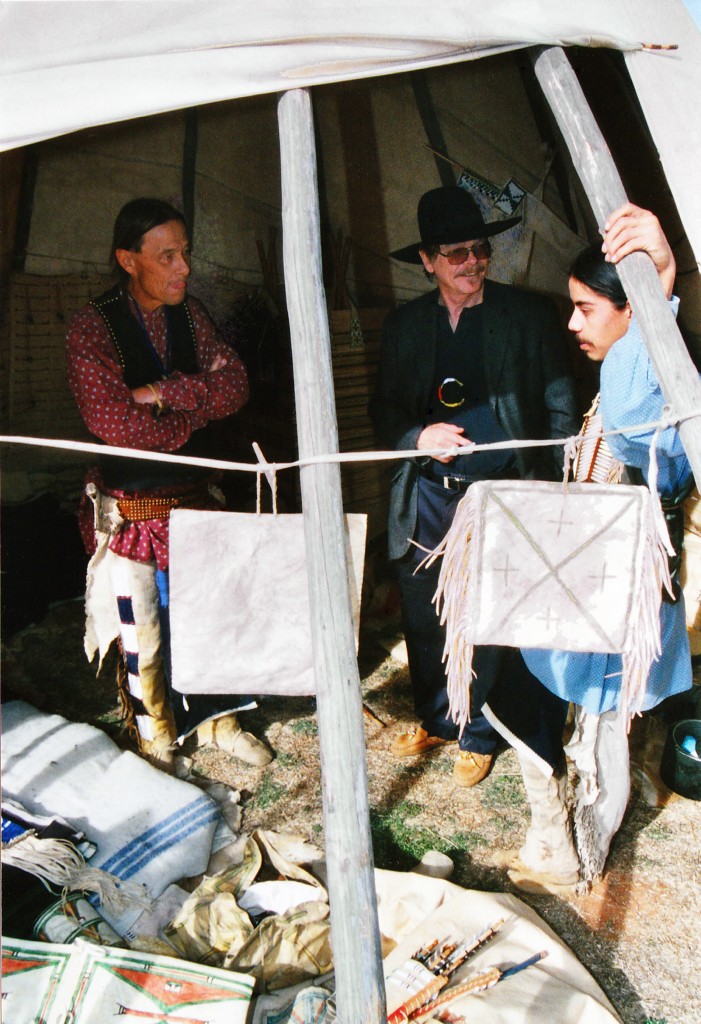
Other friends attended the last day of the event, Cheyenne Ivan Hankla (a wonderful man who opened his heart to me, but unfortunately this would be the last time I would ever see him in person) and Kiowa James Coverdale. I had met both of them at a major Fort Larned event years before and we had kept a long-distance friendship over the years.
LK with Southern Cheyenne Ivan Hankla (left) and his nephew Jake in Ivan’s fully functional lodge during the last day of the Washita Battlefield NHS’s 140th anniversary of the destruction of Black Kettle’s Cheyenne village. … It’s been too long since I’ve visited the Washita Battlefield (the last time was in 2012 when I flew to Oklahoma City for the Wrangler Awards), and methinks I need to pitch a talk for 2017. (photo © Leroy Livesay 2008; note that before Leroy’s death on 21mar2014 he gave me full permission to use his photos)
Cheyenne Blood
Tom and I had discussed doing a play dealing with the same subject matter that we had used in the one-man shows by 2007 and perhaps a little earlier. I had come up with a script with a cast of 1000s but most of the characters would have been played by actors that would play multiple roles. It wasn’t very good and never had a second draft.
 Tom came up with the idea of a two-character play, and this appealed to me. There had been two leading women in the initial draft: Louise Wynkoop and Monahsetah (photnetically pronounced “Mo-Nahs-e-Tah,” per my request of Dr. Henrietta Mann when we spent time together at the Washita in December 2008). By this time I knew that it would be a two-character play and It made sense to make the second character a Cheyenne (I think that we were both in agreement on this). Obviously Black Kettle would have been a good choice. Tom suggested Monahsetah, who was perhaps 17 in 1868. I liked the idea, mainly because there isn’t much known about her, and if George Armstrong Custer hadn’t been drawn to her when he viewed the captive Washita prisoners in 1868 she may have been lost to history. Due to her father’s closeness to Black Kettle, he (Cheyenne council chief Little Rock) and she often traveled with Black Kettle’s band and set up their village circle near his. As Little Rock and Wynkoop knew each other and seemed to get along, this meant that there was a good chance that Wynkoop knew her.
Tom came up with the idea of a two-character play, and this appealed to me. There had been two leading women in the initial draft: Louise Wynkoop and Monahsetah (photnetically pronounced “Mo-Nahs-e-Tah,” per my request of Dr. Henrietta Mann when we spent time together at the Washita in December 2008). By this time I knew that it would be a two-character play and It made sense to make the second character a Cheyenne (I think that we were both in agreement on this). Obviously Black Kettle would have been a good choice. Tom suggested Monahsetah, who was perhaps 17 in 1868. I liked the idea, mainly because there isn’t much known about her, and if George Armstrong Custer hadn’t been drawn to her when he viewed the captive Washita prisoners in 1868 she may have been lost to history. Due to her father’s closeness to Black Kettle, he (Cheyenne council chief Little Rock) and she often traveled with Black Kettle’s band and set up their village circle near his. As Little Rock and Wynkoop knew each other and seemed to get along, this meant that there was a good chance that Wynkoop knew her.
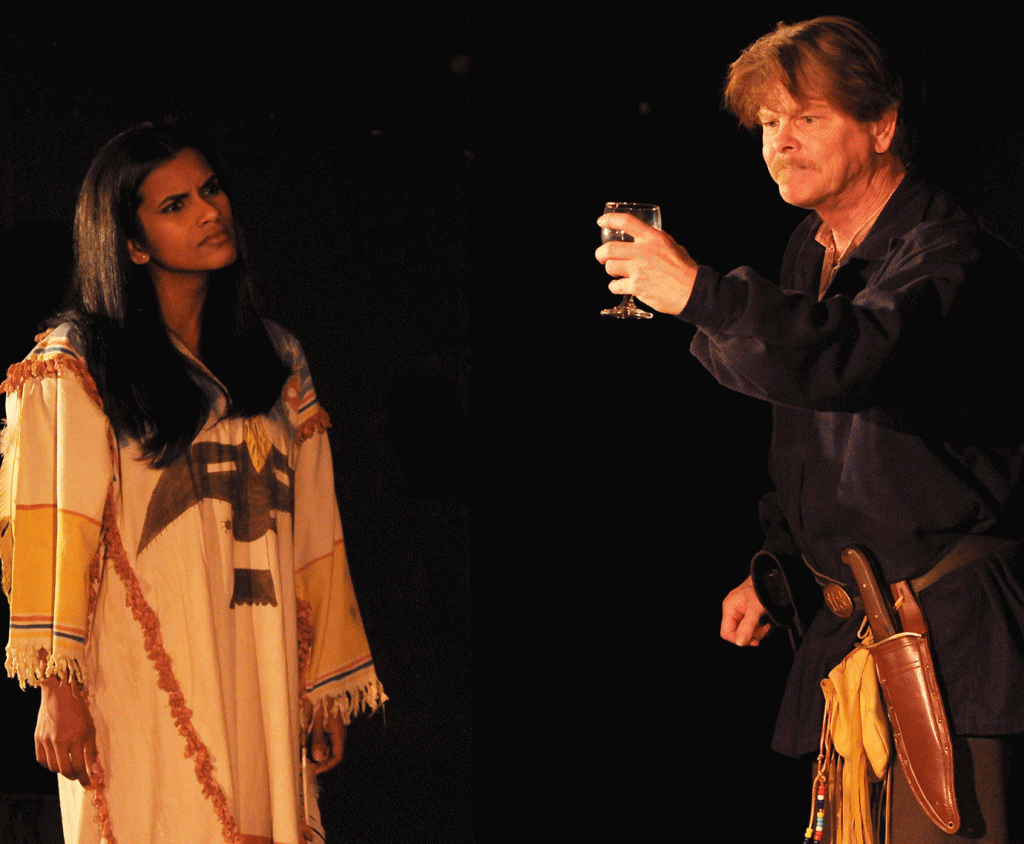
Tanya Thomas as Monahsetah and LK as Wynkoop during the drinking bit from The Drunkard. Obviously Monahsetah never saw the play but Tom added her to the scene and her presence added to the audience’s enjoyment of the bit that was played for laughs. Photo by Dean Zatkowsky (2009).
Also, and this was important, for other than Monahsetah’s contribution to Custer’s peaceful roundup of still-warring Cheyennes in 1869 Texas she was, and still is, little more than a heavenly shadow that his heart-felt words brought to life when he wrote about her in the 1870s.* Her absence from the history that she lived through allowed us to have her present but watching from afar or simply just representing a Cheyenne woman when not actually performing as herself. As it worked out, audiences accepted Tanya Thomas’s performance as Monahsetah at all times.
* Custer’s My Life on the Plains is still in print, as is Elizabeth Bacon Custer’s Following the Guidon, in which she shares her view of the young Cheyenne woman who spent time with her husband in the field and who obviously liked him. For secondary books see LK’s Custer and the Cheyenne: George Armstrong Custer’s Winter Campaign on the Southern Plains (Upton and Sons, 1995) and Peter Harrison’s Monahsetah: The Life of a Custer Captive (The English Westerners Society, 2014). There is biography by a supposed relative called Princess Monahsetah: The Concealed Wife of General Custer (2008) that is little more than bad fiction and should be avoided.
I finally had a draft of Cheyenne Blood early in 2009, and rehearsals began in March at the Petit Playhouse in Heritage Square.
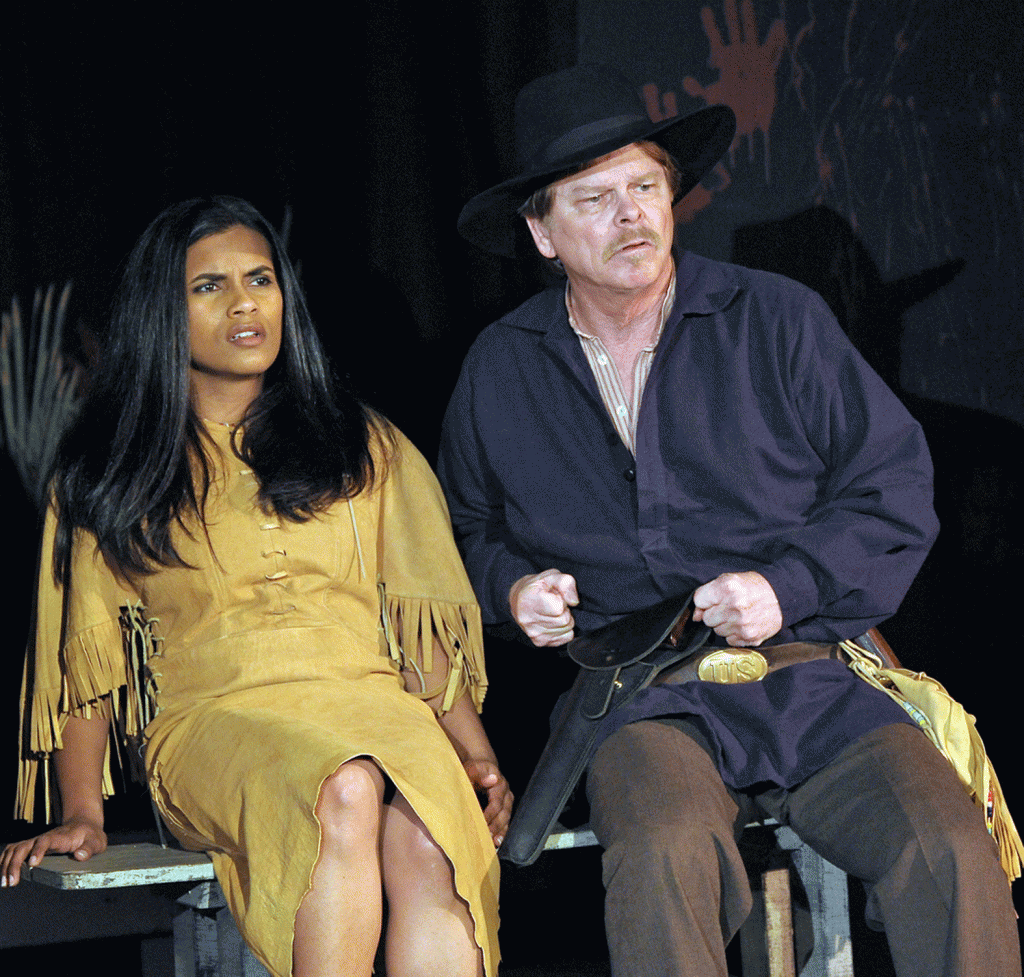
A tense moment during the ride to Denver. Tanya Thomas as Monahsetah and LK as Ned Wynkoop react to what is going on around them. This did not happen in reality, however, the seven Cheyenne and Arapaho chiefs did ride in a wagon to Denver. Wynkoop was mounted on his horse during the September 1864 trip. Photo by Dean Zatkowsky (2009).
Cheyenne Blood was a difficult play to learn, and I should admit up front that I’m terrible at learning lines. During one of the rehearsals I couldn’t remember a line or two and ad libbed what Wynkoop would have said.
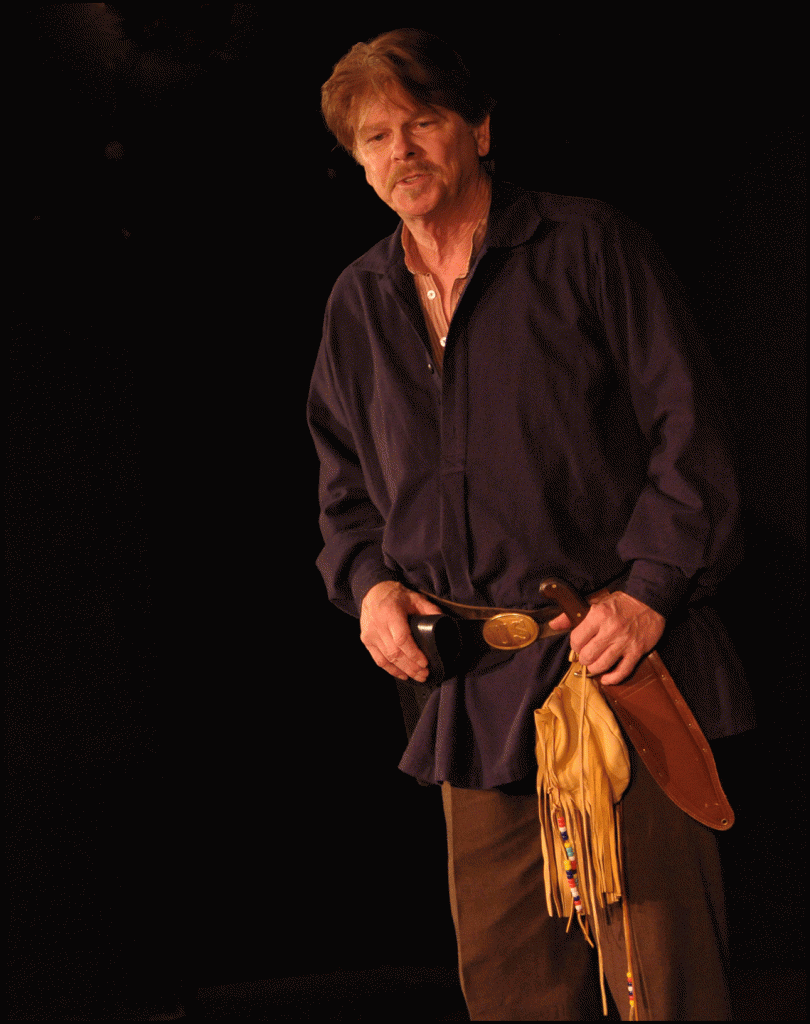
LK as Wynkoop breaking the fourth wall and talking to the audience. The Petite Playhouse was intimate and I enjoyed this no end during the run of Cheyenne Blood. In the one-man shows we had also broken the fourth wall but here if I knelt down on the edge of the stage I could have touched a person in the audience. Photo by Dean Zatkowsky (2009).
Tom stopped the rehearsal and said: “You didn’t say the correct lines.” There was more, but not for your viewing pleasure. “What I just said are now the lines,” I said. “Huh?” he replied. “I just rewrote my script. Did you write the new words down?” Tom grumbled, and I looked at the script to put the lines back in my head so we could continue with the rehearsal. I think that Tanya silently enjoyed the exchange.
Actually Tom and I had many exchanges over lots of thoughts and views that had nothing to do with getting Cheyenne Blood ready for its premier. All fun and games as we toyed with each other with words, … and Tanya quietly chuckled. At one point she said something like: “You two are a hoot.”
It’s fun to work with people you like and trust.
Without a doubt Tanya Thomas is the best actress that I’ve ever been fortunate to act with on stage. This is a big compliment. I enjoyed every minute of the time that Tanya, Tom, and I spent together during the production.
The Elite Theatre Company’s new home
The Elite Theatre Company (ETC) moved from its original location at the intimate Petit Theatre in Heritage Square where it had been since its inception in 1994 to its new home at Oxnard’s Channel Islands Fisherman’s Wharf in 2013.
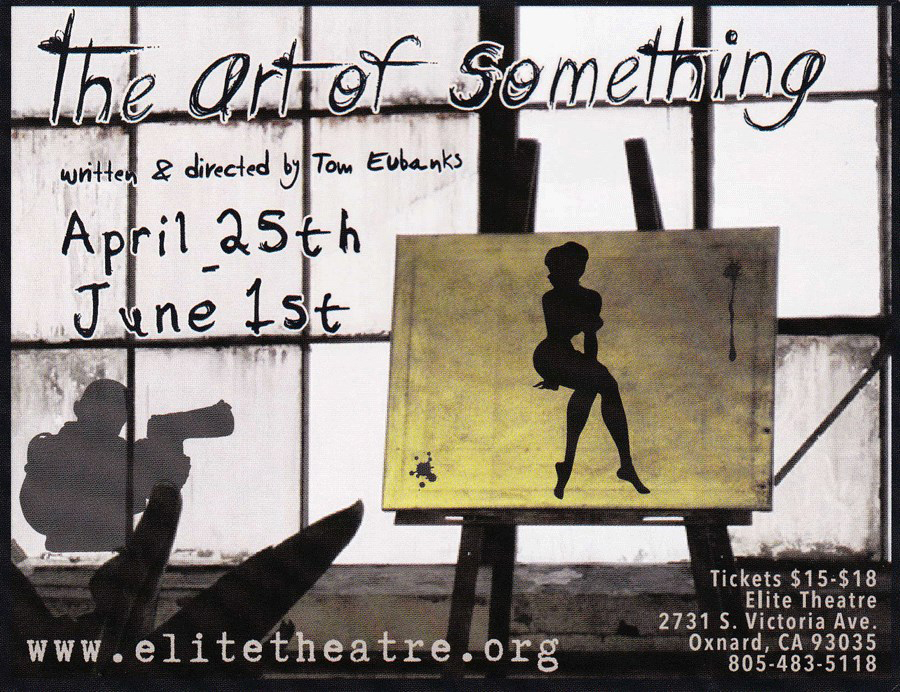
The Elite Theatre Company’s art for the premier of The Art of Something.
Pailin meets Mr. Eubanks
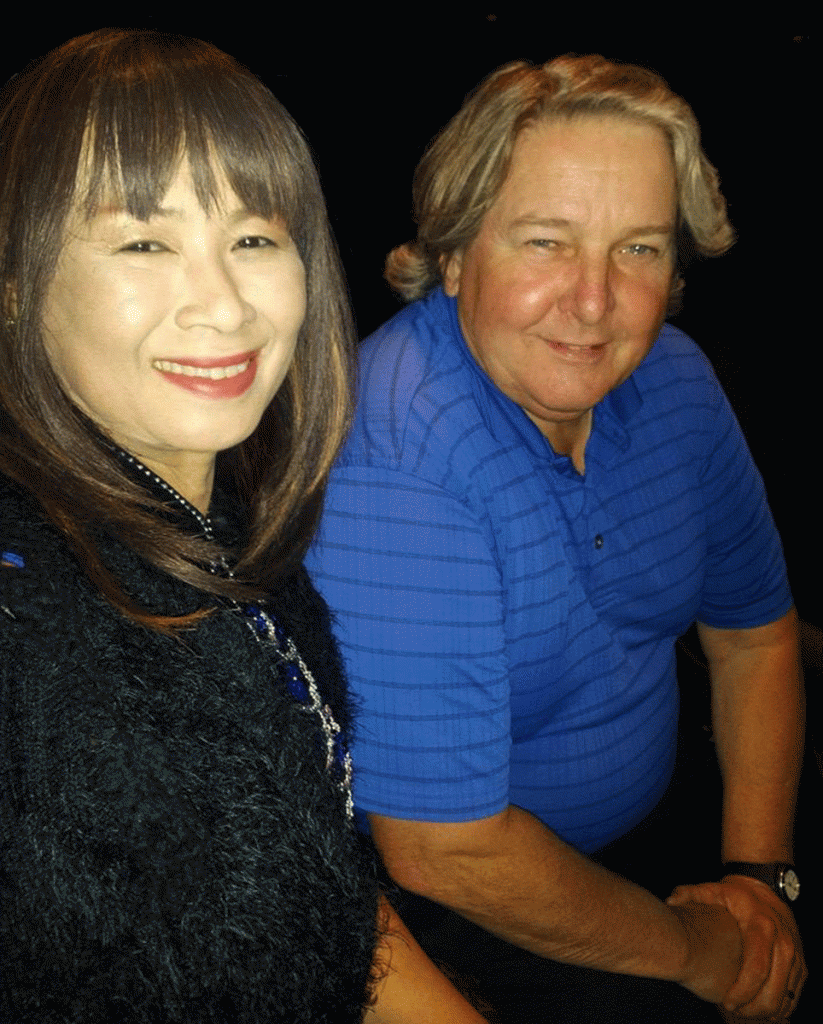
I took this image of Pailin and Tom before the final dress rehearsal for The Art of Something. (photo © Pailin Subanna-Kraft, Tom Eubanks, and Louis Kraft 2014)
Pailin and I made the drive to the Elite Theatre Company’s new home on 24apr2014. The theatre complex is housed in a two-story wooden Cape Cod-style building with two proscenium stages and is a joy to behold.
On this evening Pailin met Tom for the first time and obtained a first-hand introduction to the theater world that is in my blood and will be until the end. As a bonus she saw a play performed on stage for the first time in the USA. And best, I knew that it would a good experience for her since would see a story that Tom wrote and directed.
On the night of the final dress rehearsal for Tom’s The Art of Something at the new venue Pailin also met Tom’s wife Judy and daughter Hannah.
Since that first day and evening when I met Pailin at a dinner party at Tujunga House in June 2013 (it was supposed to be two couples and myself but one of the ladies pushed me to allow one of her friends to attend and then she pushed Pailin that she needed to make it a party of six) when she was quiet but totally attentive to what was going on around her, I have come to know that this is a major part of her inner being. … And it was the same when she saw The Art of Something on that night over two years ago but which still feels like last week.
Yes it had been a good night for Pailin when she met Tom and part of his family, but it had also been good for me to again hang out with him if only for a short while after a way-too-long passage of time.
“To be or not to be”* Wild Bill Hickok
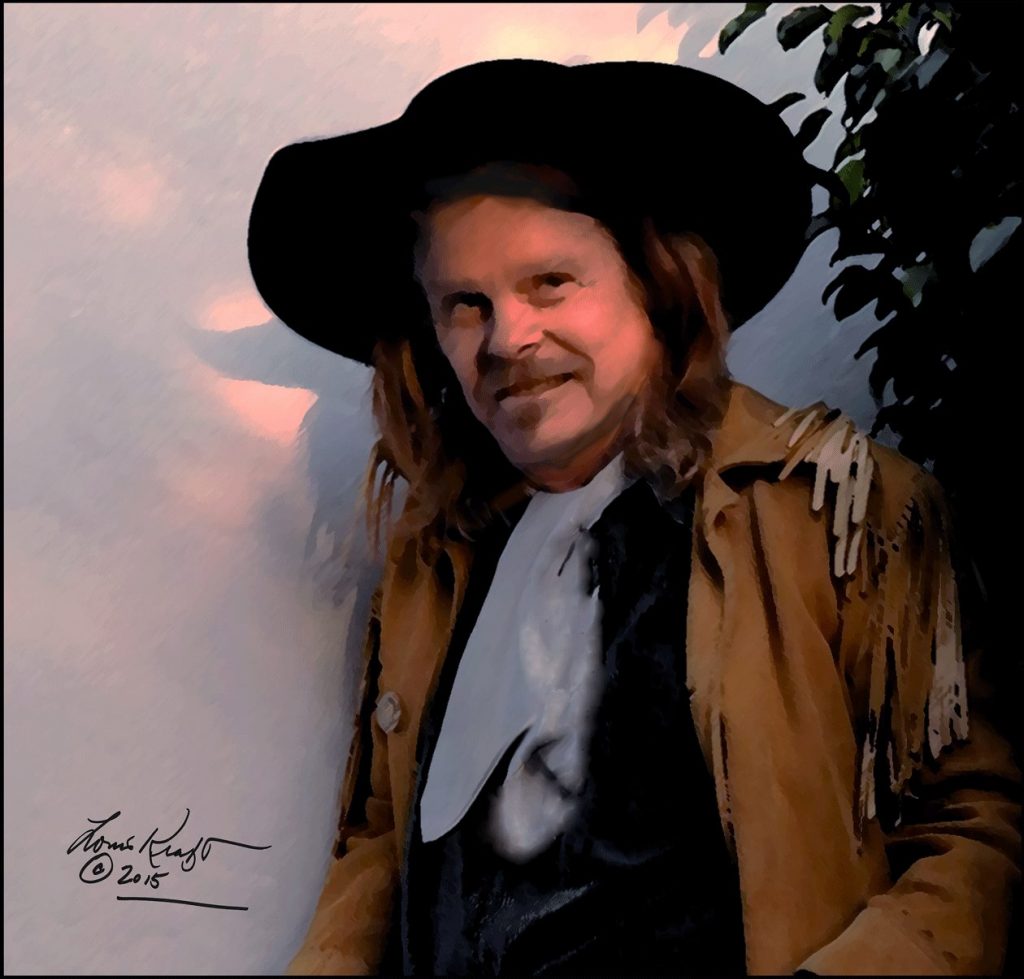
LK as Wild Bill Hickok. (art © Louis Kraft 2015)
I can’t remember when, but years back Johnny D. Boggs sent me his novel about Wild Bill Hickok joining Buffalo Bill Cody and Jack Omohundro on a theatrical tour of the East called East of the Border. Hickok quickly realized that acting wasn’t for him. Bored, he drank too much and allowed his disgust with the situation show. Eventually he realized that if he fired his revolver loaded with a blank too close to a dead Indian on the stage the extra playing the corpse jerked spasmodically while he screeched out in pain. This tickled Hickok’s fancy (I assume that this was Mr. Boggs’s invention) and continued to do it to the dismay of Buffalo Bill and the extras. … It tickled my fancy too—but then I guess I may have enjoyed knowing Mr. Hickok if given the chance—and I decided that I wanted play the scout-gunman-gambler on stage.
* Although I quoted William Shakespeare’s Hamlet (written in 1601 or 1602 and first performed in 1602) I’m not depressed or considering ending my life. Just the opposite, I’m thrilled to move into my future. … I’m just having a little fun with the Bard’s words at Wild Bill’s expense.
Now came the hard part; getting Johnny to buy in on his novel being turned into a play. I approached him on this numerous times over the years and he never replied. In 2012 when I attended a WWA convention in Albuquerque, New Mexico, I again approached Johnny. No reply, but Lisa Smith, his wife and my friend, said: “That’s a great idea.”
Of course I wanted Tom to direct East of the Border if Johnny had agreed to me writing a play based upon his book, but this was beginning to be little more than wishful thinking. Worse, Tom was also lukewarm to the idea until I gave him a couple of books when I saw a play that he had directed called Men of Tortuga at the Elite Theatre in May 2016 (one 38-minute scene with two actors—Ron Rezac and Adam Womack—sitting at a table was riveting and had me on the edge of my seat).
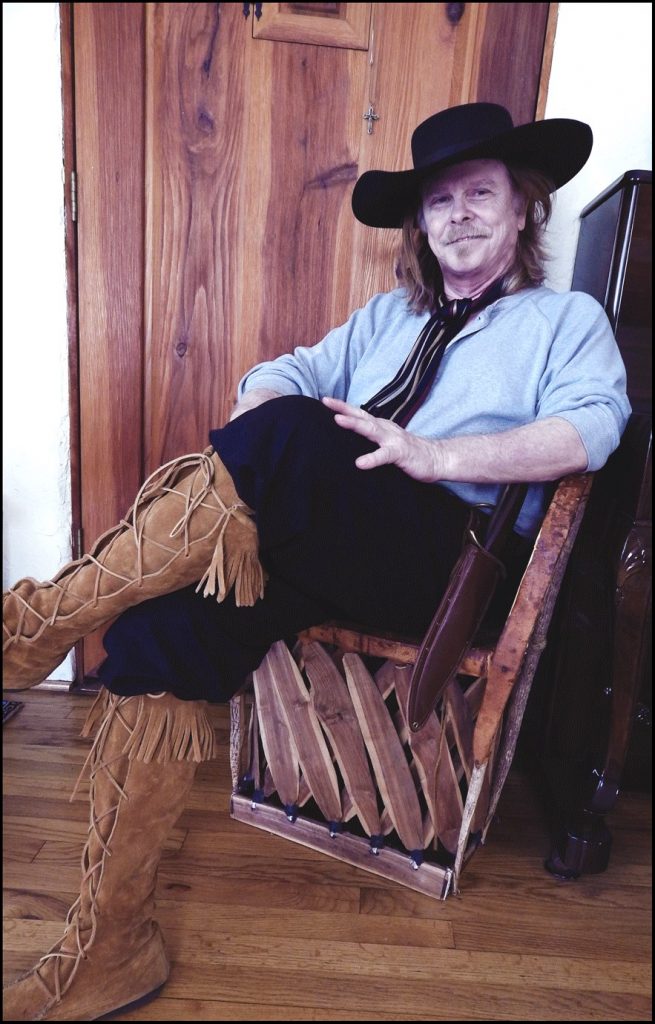
LK as LK (or Wild Bill) relaxing at home in September 2015 (photo © Louis Kraft 2015)
To this point in time I still wanted to play Wild Bill Hickok on stage and thought that Johnny’s novel would be the perfect vehicle to bring my desire to fruition.
Back to the books that I gave Tom; one was Boggs’s East of the Border. Tom read it, called me, and we discussed what he thought needed to happen to make the novel work on stage (mainly condensing the story, removing the repetition, and focusing on three or four characters). This would have certainly been doable if Boggs would only buy into the idea.
Since Cheyenne Blood I’ve wanted to return to the stage, and thought it would be fun to play Hickok as he was burned out and certainly out of his element play-acting on stage. Alcoholism and a sadistic sense of fun would have made him a wonderful stretch for me.
After my phone conversation with Tom ended and I hung up I knew what I wanted to do … what I really wanted to do.
In the Midst of All that is Good
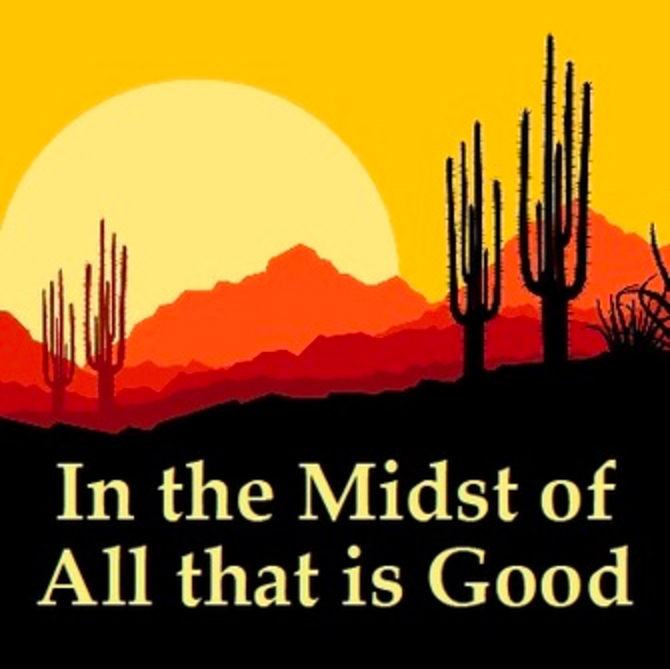
The Elite Theatre Company’s art for the premier of In the Midst of All that is Good.
On Saturday 13aug2016 I saw a great play written by Tom Eubanks. I’ve seen a lot of the plays that he has directed or written and directed since 1990, but this one was special.
I had hoped to create this blog that dealt with Tom’s and my friendship, our working relationship, In the Midst of All that is Good, and Wild Bill Hickok before the play closed at the Elite Theatre on 21aug2016 to give it additional publicity. Good attempt by me, but there just wasn’t enough time as I also had to pound the midnight oil as I push to complete my manuscript, Sand Creek and the Tragic End of a Lifeway, which may be the most important book that I ever write (and this currently includes a great ongoing communication with Gary Roberts, who has written numerous books and documents about the tragedy), as well as deal with yet another operation (my nineteenth).
LK and Tom Eubanks at the Elite Theatre on the evening that I saw In the Midst of All that is Good. Obviously religion has played a large role in Tom’s life. Over the years he has prayed for me and I have for him. (photo © Louis Kraft & Tom Eubanks 2016)
Tom has written and directed a lot of plays that have been extraordinary, but this play is by far my favorite.
According to Tom (whose father, Sam Eubanks, is an evangelical pastor), he spent, “most of my early life planted in a pew.”
His early life started a spark that pushed him “to get a few things off my chest,” and write In the Midst of All that is Good. I think he told me that it took him a year to write and fine tune with comments from six friends that he mentioned by name in the program. I’m certain that after casting was set and rehearsals began that the play continued to evolve. I couldn’t take my eyes off Josh Carmichael, who was totally natural while at all times a threat to everyone else on stage as he raised questions and protected his livelihood. Jeff Ham also shined, as did David Fruechting, who was terribly sick during the performance that I saw and had been in the emergency room the previous night. If I hadn’t known, I would never have guessed. Hannah, Tom’s youngest daughter, played a key role in the play; she’s fifteen and was terrific, as was Alex Czajka, who as a young actor was totally believable as her deaf brother. Finally, Johnny Avila, as an almost flashback to the days of love-ins and hippies, reminded me of my brother’s best friend and our baseball teammate for 10 years until a mere flick of time ended Lee’s life in a flash.
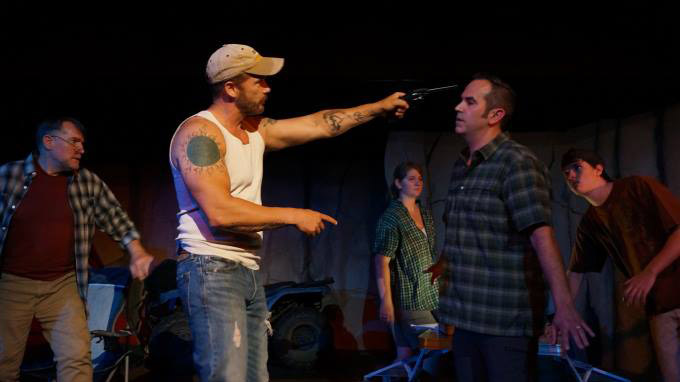
In the above photo: Josh Carmichael (Vic) points his gun at Jeff Ham (Reverend Bob) while his children Hannah Eubanks (Maddie) and Alex Czajka (Carson, who is deaf in the play) nervously react to the threat behind their father). David Fruechting (Lloyd, Reverend Bob’s disgraced and long-retired father) is about to jump Vic from behind. Johnny Avila (Dennis, Vic’s brother-in-law and partner isn’t shown in the image). Photo courtesy of the Elite Theatre Company.
See the theater’s website for upcoming plays: http://www.elitetheatre.org/.
Adios Wild Bill … enter Errol Flynn stage left
During our time together at the Elite Theatre that August 13 night Tom and I had time to chat. Early on I told him that I wanted to discuss something (and I’m certain that he thought it would be Mr. Hickok). … When we finally had the chance to talk I went for broke and threw a curveball at Tom a la Clayton Kershaw of the Los Angeles Dodgers.
I knew one thing moving forward, adios Mr. Hickok. … And honestly I didn’t know what to expect when I made the pitch.
I think that the role that I enjoyed playing the most on stage was Charley in Eat Your Heart Out. I played Charley at the Hayloft Dinner Theater in Lubbock, Texas (1976), and in Inglewood, California (1977). I luckily landed a great part in a great play. Eat Your Heart Out is about an actor trying to land acting work while waiting tables.
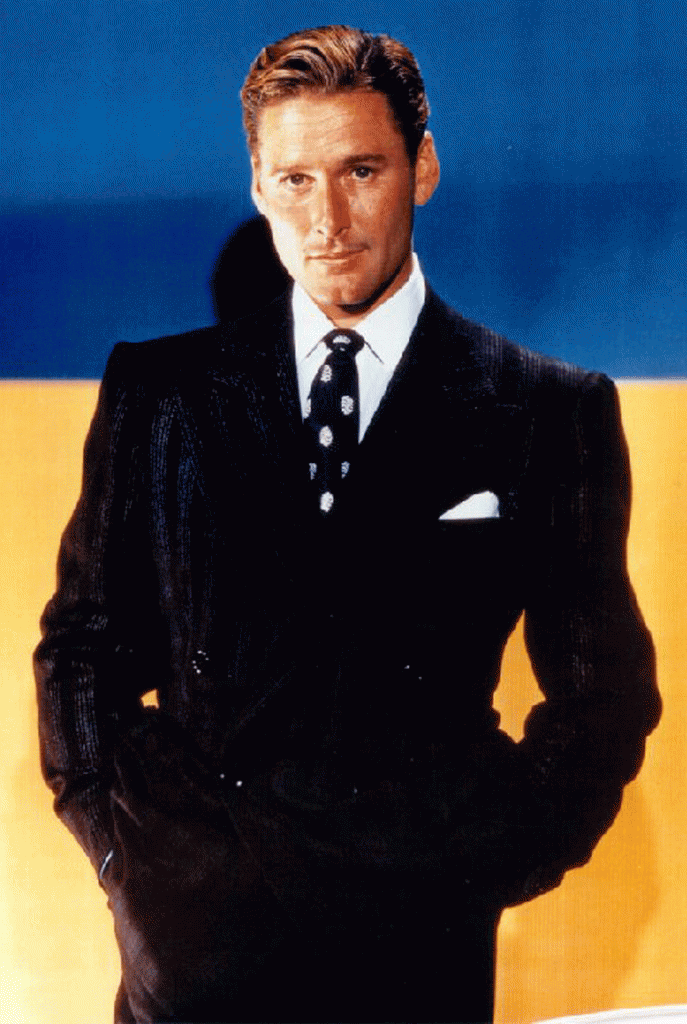
Errol Flynn circa 1940-1941. LK personal collection.
There are four other actors in Eat Your Heart Out: Two women and two men who play various roles, and this is how I pitched a play on Errol Flynn to Tom but with a second historical figure on stage with him (can’t name him, sorry).
While proposing a play dealing with Flynn I also pitched using additional actors to play various roles but was vague if it would be two or three men and two or three women on stage with Flynn and the mystery man. I lean toward Flynn/other person plus six for a total of eight actors but know that Tom prefers a total of six actors. There could also be a compromise and have three actors (Flynn, one male, and one female) that play one character, and two men and two women who play various roles (for a total of seven).
Obviously identifying the characters is of utmost importance, and if truth be told they have already been selected. Don’t ask, for I ain’t a sharin’ their names. Once each player’s relevance to the play is in place an outline is mandatory to insure that this is true and that the actors that play various roles will have time to change costumes and characters. Unfortunately all of the details must remain secretive until the play is in production.
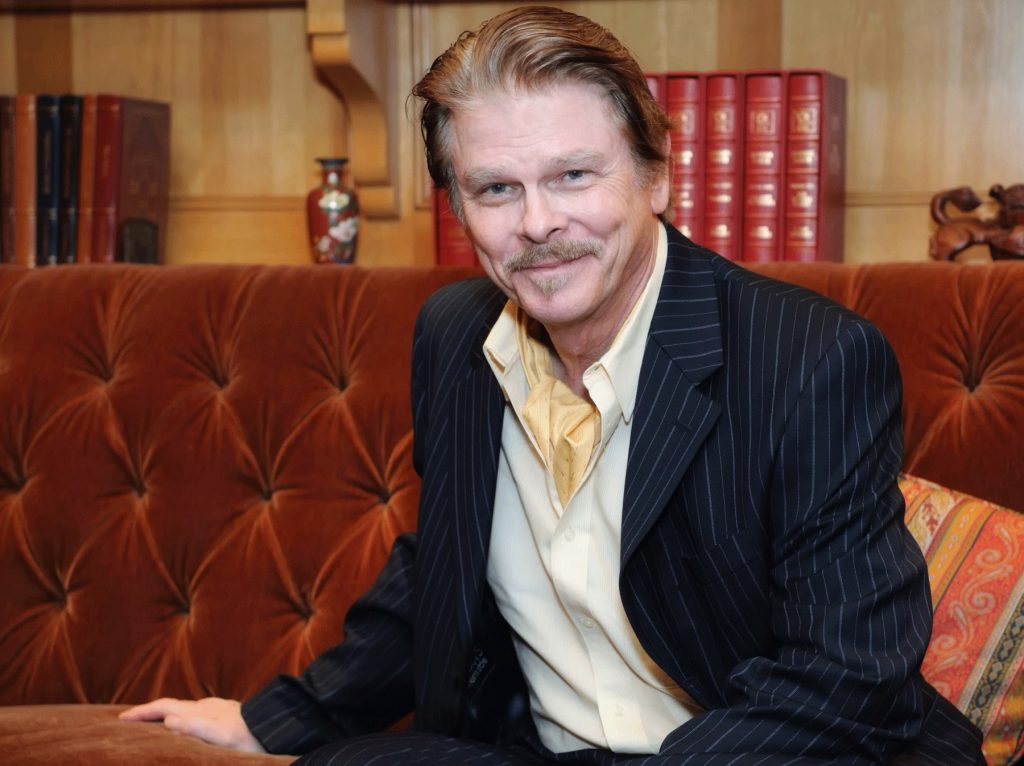
See … LK can clean up as this photo by Steve Buffington proves. More important, I know Errol Flynn. (photo © Louis Kraft & Steve Buffington 2010)
History repeats itself: Like Leo Oliva in 2000, Tom asked if I could have the play written by next year (due to some changes that might happen with the Elite Theatre Company’s future scheduling). I told him “no,” as I needed to complete the delivery draft of Sand Creek and the Tragic End of a Lifeway first. Once the Sand Creek book is in production at OU Press I’ll be on Errol & Olivia* full time and it will be perfect timing for doing a play on Mr. Flynn.
* For the record I plan on writing three books about Errol Flynn, but will space them between Indian wars books that deal with race relations (that is if I’m able to successfully pitch my next Indian wars subjects to OU Press).

